News
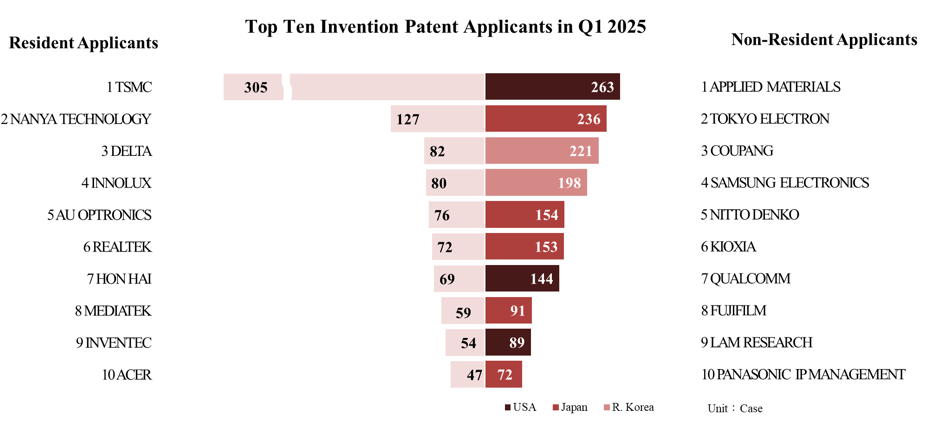 1
1TIPO’s Q1 2025 IPR Statistics Report
Overall Trends in Patent and Trademark ApplicationsIn the first quarter of 2025, TIPO received a total of 17,063 patent applications, comprising 12,202 invention patents, 3,232 utility model patents, and 1,629 design patents. This represents a 1% increase compared to the same period in 2024, with invention patent filings rising by 2% (Figure 1). Patent applications filed by resident and non-resident applicants accounted for 47% and 53% of the total, respectively. Compared to the same period last year, applications by residents declined by 2%, whereas those by non-residents rose by 5%.A total of 21,099 trademark applications were filed. Since a single trademark application may be designated across multiple classes, the total number of classes covered by trademark applications reached 27,445, a 2% increase (Figure 2). Among these, resident applicants accounted for 77%, while non-resident applicants made up 23%. The number of trademark classes, originally on a decline, has shifted to growth.Overview of Patent Applications Filed by ResidentsTop Ten Invention Patent ApplicantsAmong the 4,355 invention patent applications filed by resident applicants, 3,534 were submitted by businesses. TSMC led the top ten resident applicants with 305 filings, followed by Nanya Technology (127), Delta (82), Innolux (80), AU Optronics (76), Realtek (72), Hon Hai (69), MediaTek (59), Inventec (54), and Acer (47) (Figure 4). Notably, TSMC has held the top position for six consecutive years since the first quarter of 2020. Another highlight is Delta, which posted its strongest single-quarter performance ever, both in terms of application number and ranking.Top Five Design Patent ApplicantsResident applicants filed 682 design patent applications. The top five applicants were L&F Plastics with 27 applications, followed by Tarng Yu (22), Acer (18), Crown (12), and a four-way tie between Tong Yah, Evolutive, Shin Tai, and Gudeng, each with 9 applications (Figure 5). L&F Plastics has held the top position for two consecutive years, while both Evolutive and Gudeng made their debut appearances in the top five.Overview of Patent Applications Filed by Non-ResidentsFiling Countries (Regions) of Invention Patent ApplicantsNon-resident applicants filed 7,847 invention patent applications. The top five countries/regions are Japan with 3,538 applications, followed by the US (1,624), R. Korea (828), Mainland China (706), and Germany (230) (Figure 3). All five countries/regions saw year-on-year growth in application numbers. In particular, applications from Japan and R. Korea increased by 213 and 113 cases respectively, reflecting a growing emphasis on the Taiwanese market.Top Ten Invention Patent ApplicantsAmong the top ten non-resident applicants for invention patents, Applied Materials from the US ranked first with 263 applications. It was followed by Tokyo Electron (236) from Japan, Coupang (221) from R. Korea, Samsung Electronics (198) from R. Korea, Nitto Denko (154) from Japan, Kioxia (153) from Japan, Qualcomm (144) from the US, Fujifilm (91) from Japan, Lam Research (89) from the US, and Panasonic IP Management (72) from Japan (Figure 4).Applied Materials (US) maintained its leading position among non-resident applicants for the third consecutive year, together with four other companies—Tokyo Electron (Japan), Kioxia (Japan), Lam Research (US), and Panasonic IP Management (Japan)—each setting their own record for the highest single-quarter performance. This trend underscores Taiwan’s strategic role in global semiconductor production and R&D, attracting equipment suppliers and related industries to strengthen their technical and market protections in Taiwan. Taiwan’s technological capability and comprehensive regime for intellectual property protection also draws international investors.Filing Countries (Regions) of Design Patent ApplicantsNon-resident applicants filed 947 design patent applications. The top five countries/regions were the US with 219 applications, followed by Japan (212), Mainland China (160), Switzerland (79), and R. Korea (54) (Figure 3). Notably, the US surpassed Japan this quarter to take the top position.Top Five Design Patent ApplicantsAmong the top five non-resident applicants for design patents, Beijing Roborock from Mainland China led with 58 applications, followed by Apple (45) from the US, Molex (37) from the US, Harry Winston (31) from Switzerland, and Renault (30) from France (Figure 5). All five companies recorded year-on-year growth in application numbers, highlighting the increasing importance of the Taiwanese market and the need to actively invest resources to safeguard the competitive edge of product designs.Overview of Trademark Registration ApplicationsTop Ten Resident Applicants for TrademarksResident applicants filed 16,188 trademark applications. Among the top ten applicants, Uni-President ranked first with 122 applications, followed by TSG Hawks (111), Che Tai (87), Nan I Book (83), Xing Han (75), Amber Dong Fu and A-Top Health (both with 43), Chunghwa Post (42), Adam (40), and Videoland (38) (Table 1). Except for Uni-President, all other top ten applicants recorded year-on-year growth.NICE Classification of Resident ApplicationsThe top three categories of trademark applications filed by resident applicants were as follows: Class 35 (advertising, business management, retail and wholesale services, etc.) with 3,179 applications, Class 43 (restaurants, lodgings, etc.) (1,529), and Class 30 (coffee, tea, pastries, etc.) (1,352) (Figure 7). This trend indicates that domestic businesses tend to focus their trademark applications on business operations, as well as consumer-related services such as restaurants and accommodations, and products like coffee and pastries.Filing Countries (Regions) of Non-Resident ApplicationsNon-resident applicants filed 4,911 trademark registration applications. The top five countries/regions were Mainland China with 1,212 applications, followed by Japan (757), the US (708), R. Korea (633), and Singapore (223) (Figure 6). Except for Mainland China, the number of applications from the other four countries increased. Japan, R. Korea, and Singapore have seen positive growth for two consecutive years, reflecting a stronger focus on trademark and brand protection in the Taiwanese market by companies from these countries.Top Ten Non-Resident Applicants for TrademarksAmong the top ten non-resident applicants for trademark registration, JYP from R. Korea ranked first with 63 applications, followed by Musinsa (60) from R. Korea, Goodbaby (42) from Mainland China, GR OPCO (41) from the US, Huawei (34) from Mainland China, Huang, Cheng-fang (33) from Mainland China, Tencent (26) from Cayman Islands, Blooming (25) from R. Korea, CYYS (24) from Hong Kong, and the Row Holdings (22) from the US (Table 2). Except for Tencent, which saw a 38% decrease in applications, all other top ten applicants recorded year-on-year growth.NICE Classification of Non-Resident ApplicationsThe top three categories of trademark applications filed by non-resident applicants were as follows: Class 9 (computer and technology products, etc.) with 966 applications, Class 35 (advertising, business management, retail and wholesale services, etc.) (623), and Class 3 (cosmetics and detergents, etc.) (550) (Figure 8). Non-resident applicants have focused primarily on registering trademarks in Class 9 (computer and technology products, etc.), which had the most applications and experienced a higher growth rate.Analysis of Applications by IndustryThe most commonly filed trademark applications in Taiwan were in the “Agriculture” industry, with 5,190 applications, leading all industries. This was followed by “Health” (4,337) and “Business services” (4,289).The top three industries for trademark applications were as follows: for resident applicants, “Agriculture” led with 4,361 applications, primarily driven by trademark filings from restaurants and accommodation services; for non-resident applicants, “Research and technology” had the highest number of filings with 1,477 applications (Figure 9). Additionally, resident applicants saw year-on-year growth in the “Business services” industry, while non-resident applicants experienced growth in “Research and technology,” “Health,” and “Clothing and accessories.”Note: The above statistical data is based on the “first applicant” of the applications when referencing applicants and nationalities. Reference URL: https://www.tipo.gov.tw/en/lp-302-2.html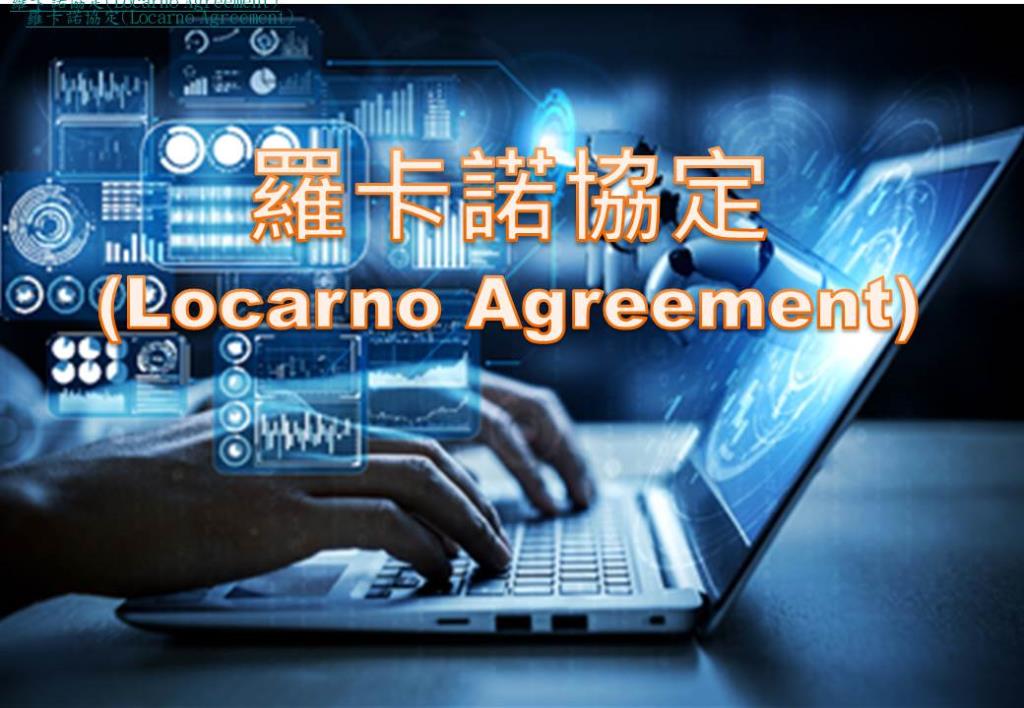 2
2The 15th Edition of the Locarno Agreement Establishing an International Classification for Industrial Designs Now in Effect
The 15th Edition of the Locarno Agreement Establishing an International Classification for Industrial Designs, administered by WIPO, officially came into effect on January 1, 2025. TIPO has completed the Chinese translation and prepared a comparison table between the old and new versions for public reference.Key updates in this edition include: new categories for lighting fixtures and personal grooming products, as well as more detailed classification for graphic designs and virtual reality (VR) products to reflect the needs of emerging industries and current design trends.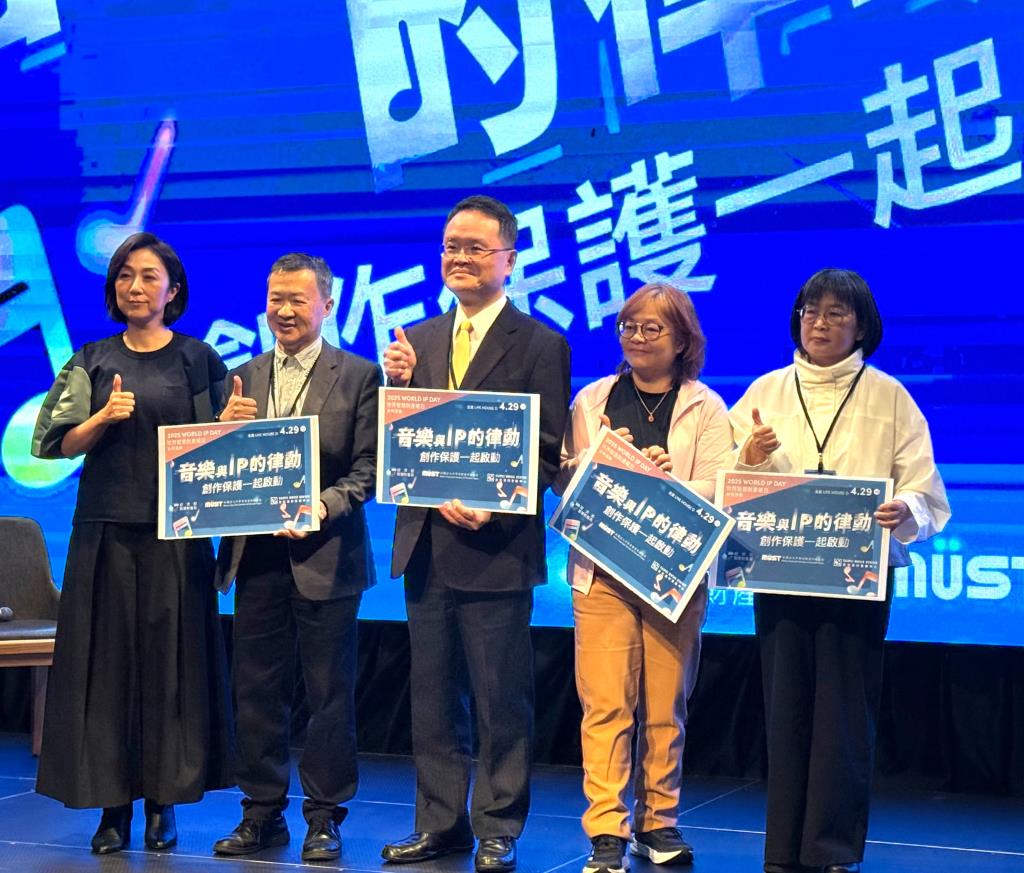 3
3“Rhythms of Music and IP: Launching Creative Protection” Forum a Resounding Success!
In celebration of World IP Day 2025 and the theme, “IP and Music”, TIPO collaborated with the Music Copyright Society of Chinese Taipei (MÜST) and the Taipei Music Center (TMC) to organize the “Rhythms of Music and IP: Launching Creative Protection” Forum. The event took place on April 29, 2025, at the Live House D exhibition space of Taipei Music Center, drawing over 150 participants from the music industry, academia, and the creative community. The event was marked by lively interaction, reflecting a strong collective interest in music and intellectual property rights.In his opening remarks, Director General Cheng-Wei Liao expressed his gratitude for the opportunity to co-host this event with MÜST and TMC—two organizations deeply rooted in Taiwan's music industry. He noted that the seminar's theme echoed WIPO's 2025 focus, “IP and Music: Feel the Beat of IP.” Director General Liao emphasized the importance of recognizing the value of musical creativity, exploring innovative cross-industry applications, and understanding the significance of intellectual property rights protection.TIPO highlighted that with the rapid advancement of digital technology and the growing diversity of music creation and distribution, it is crucial to stay ahead of industry changes, support creators in safeguarding their rights, encourage lawful licensing, and promote both industry growth and innovative applications. TIPO remains committed to these goals, seeking to inject greater momentum into Taiwan's music and creative industries.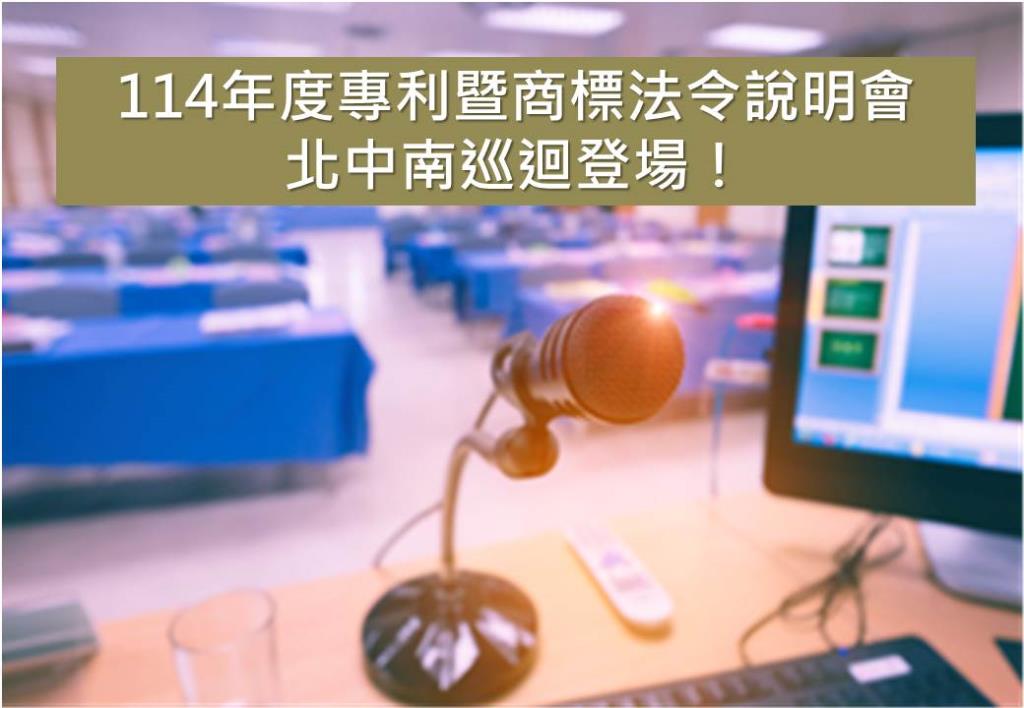 4
4TIPO Organizes 2025 Information Sessions on Patent and Trademark Laws
TIPO will hold a series of Information Sessions on Patent-Related Laws and Information Sessions on Trademark-Related Laws on May 14, May 16, and May 23, 2025, in Taipei, Kaohsiung, and Taichung, respectively. Each city will host one session for patents and one for trademarks.The patent information session will cover the latest updates to the examination guidelines for invention and utility model patents, highlighting key amendments. Meanwhile, the trademark information session will provide a detailed explanation of critical articles from the Trademark Act, addressing common practical issues encountered recently. Additionally, the session will introduce TIPO's new trademark search system, offering tips to help industry professionals improve search accuracy and application efficiency.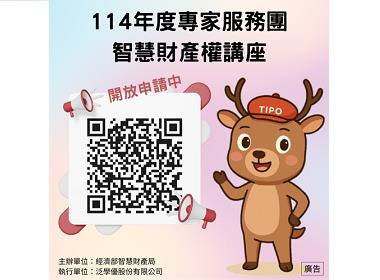 5
52025 IPR Expert Service Group Seminar Now Open for Application
TIPO is now accepting applications for the 2025 IPR Expert Service Group Seminar. This seminar is designed for businesses, government agencies, educational institutions, private organizations, and the general public interested in learning more about intellectual property rights (IPR), rights protection, and fair use. All those looking to deepen their understanding of IPR-related topics or have questions about IP protection, are encouraged to apply.There are no restrictions on the type of applicant – enterprises, government institutions, and civilian organizations are all eligible. Organizations may also file joint applications. Participants can choose between in-person or online sessions. The seminar fee covers the instructor's hourly rate (NT$2,000 per hour) and travel expenses.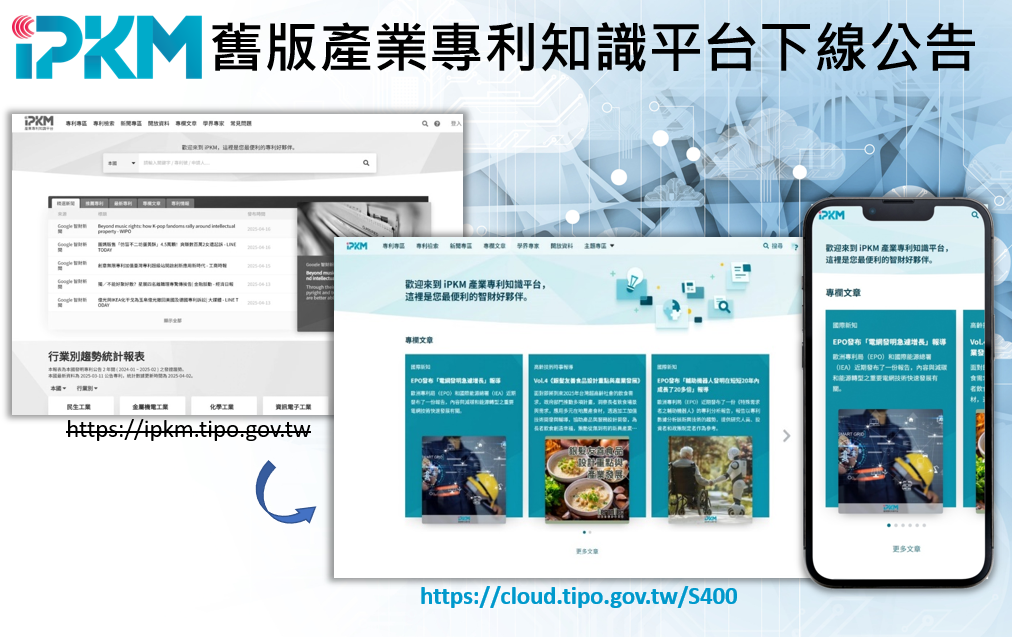 6
6TIPO Launches the New iPKM – Now Available!
To align with the government’s cloud policy and enhance service quality, TIPO officially launched the new iPKM on December 18, 2024. This revamped platform, accessible at https://cloud.tipo.gov.tw/S400, integrates the previous desktop and mobile versions into a seamless, cross-device experience. The updated user interface provides streamlined access to patent document searches, expert articles, the latest IP news, information on international patent systems, and more.Please note that the previous version of the platform will be taken offline on April 25, 2025. We encourage all users to switch to the new platform as soon as possible to continue enjoying comprehensive IP information services.Please direct any questions or feedback regarding the new system to the "Contact Us" page at https://cloud.tipo.gov.tw/S400/question/contact-us.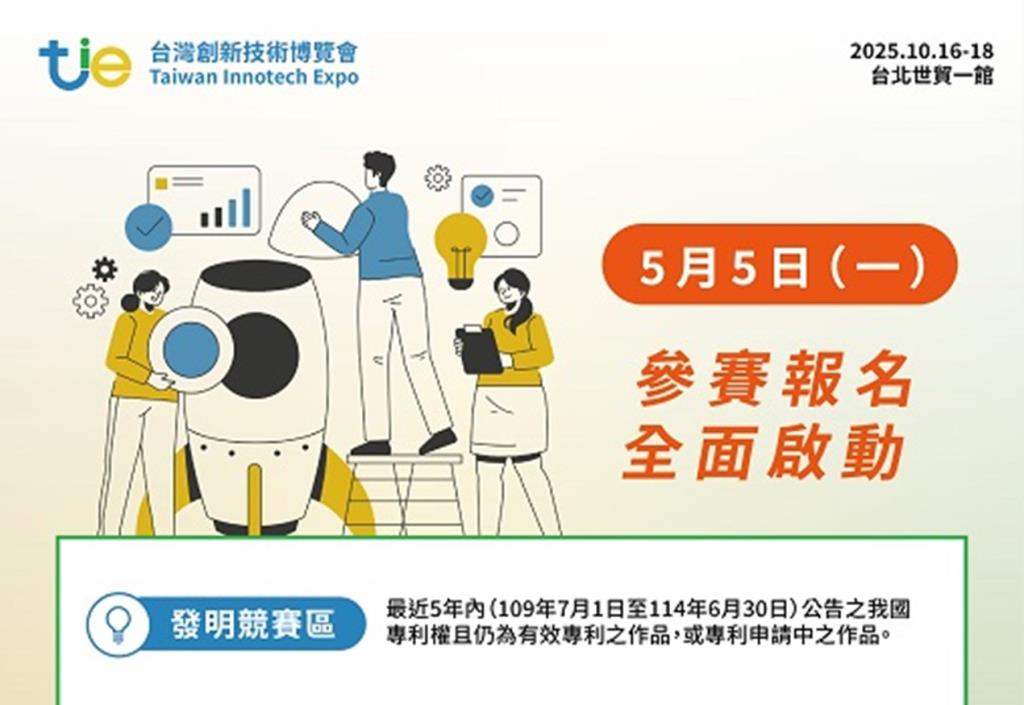 7
7The Taipei Invention Awards Competition of tie is Now Open for Registration!
The 2025 Taiwan Innotech Expo (tie) is set to take place from October 16 to 18, 2025 at the Taipei World Trade Center Hall 1. This year’s theme centers around using AI to drive cross-domain innovation and futuristic smart technology, highlighting the integration of AI applications with Taiwan's leading industries. tie 2025 sets the stage for global tech trends and draws international buyers and research institutions for exhibition and exchange.The 2025 Taipei Invention Awards Competition will also be held simultaneously in Exhibition Hall B. Inventors, manufacturers, and academic institutions with innovative ideas and passion are encouraged to sign up and showcase their work.Hosted by TIPO, the 2025 Taipei Invention Awards Competition will feature a distinguished panel of judges from industry, government, and academia who will evaluate the patents presented. An Awards Ceremony will be held on the final day of the exhibition to honor outstanding inventors and exemplary exhibitors, offering them opportunities for media exposure.tie provides a powerful platform for inventors to boost the visibility of their patents through digital networks, media, social platforms, and newsletters. This platform not only attracts industry attention but also facilitates industry-academia cooperation, technology transactions, and resource networking. The 2025 Taipei Invention Awards Competition Registration Guide is now available on the tie official website. Don't miss out on the opportunity to participate!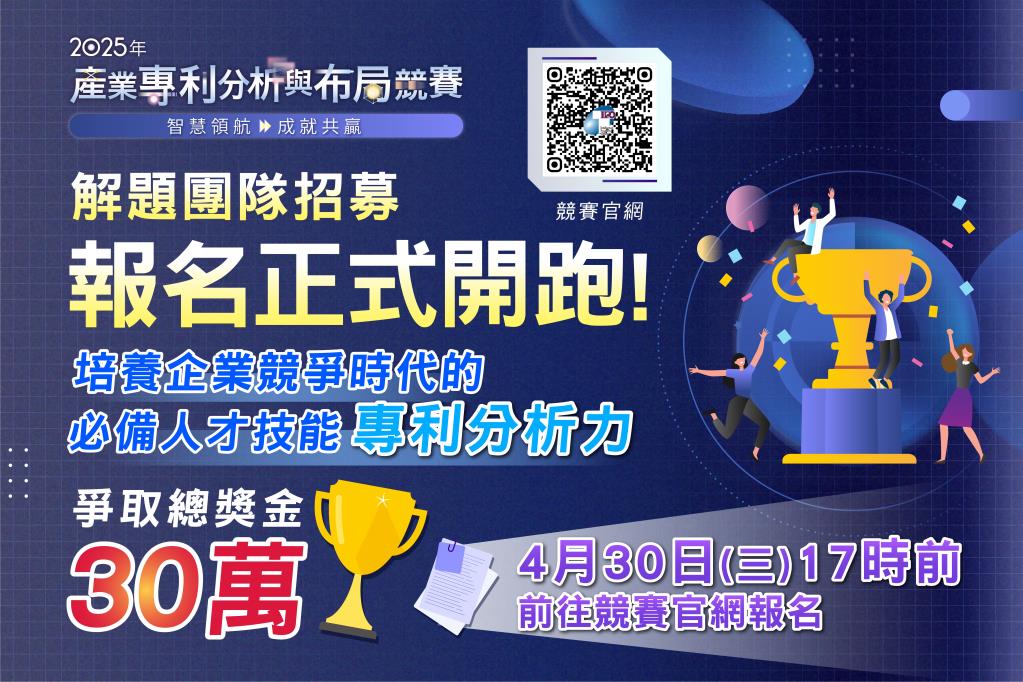 8
8TIPO Launches the 2025 Competition for Patent Portfolio Analysis
TIPO's 2025 Competition for Patent Portfolio Analysis is now open for registration until April 30, 2025. With a total prize pool of NT$300,000, the competition continues to adopt its innovative “Corporate Challenges x Talent Solutions” format, incorporating real-world business needs and industry priorities, in hopes that domestic patent analysis professionals across different sectors can participate.Since 2021, TIPO has hosted this annual event to foster a platform for cross-sector collaboration and to promote knowledge exchange on patent portfolio strategies and industry trends. This year, 30 enterprises have submitted 53 topics across diverse technical fields, including electronics and electrical engineering, ICT, biotechnology and pharmaceuticals, mechanical manufacturing, optics and imaging, smart healthcare, and green energy.To strengthen participants' practical skills, a series of hands-on training courses will be held during the competition, covering patent search techniques, data analysis methods, and strategies for building effective patent portfolios. Final results will be showcased at the award ceremony and exhibition, offering participants valuable networking opportunities with industry professionals.TIPO aims to bridge industry, academia, and research through this competition, cultivating future professionals in patent analysis while helping enterprises identify talent and stay ahead of technological trends.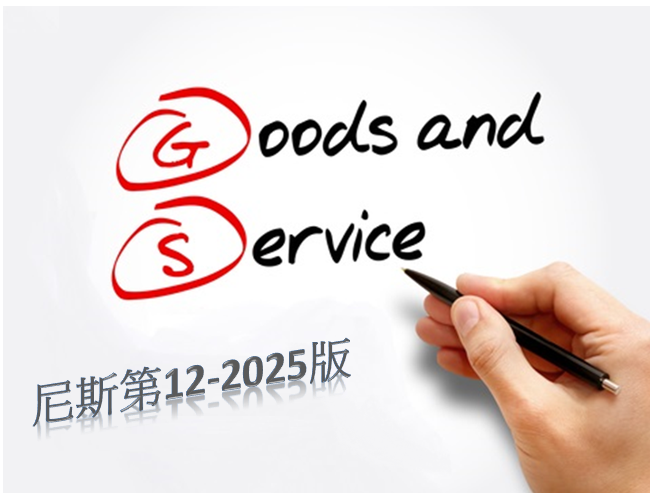 9
9TIPO Updates Taiwan-Japan and Taiwan-Korea Concordance Tables for Nice Classification (12th Edition – Version 2025)
To align with the latest updates to the Nice Classification (12th Edition – Version 2025) issued by the World Intellectual Property Organization (WIPO), TIPO has released updated versions of its Taiwan-Japan and Taiwan-Korea Concordance Tables for Similar Group Codes of Goods and Services.These concordance tables serve as practical references for applicants in Taiwan, Japan, and Korea who plan to file trademark applications with TIPO, the Japan Patent Office (JPO), or the Korean Intellectual Property Office (KIPO). By using the updated group code comparisons, applicants can more efficiently and accurately identify the designated goods or services, and conduct prior similarity searches to avoid conflicts with existing trademarks.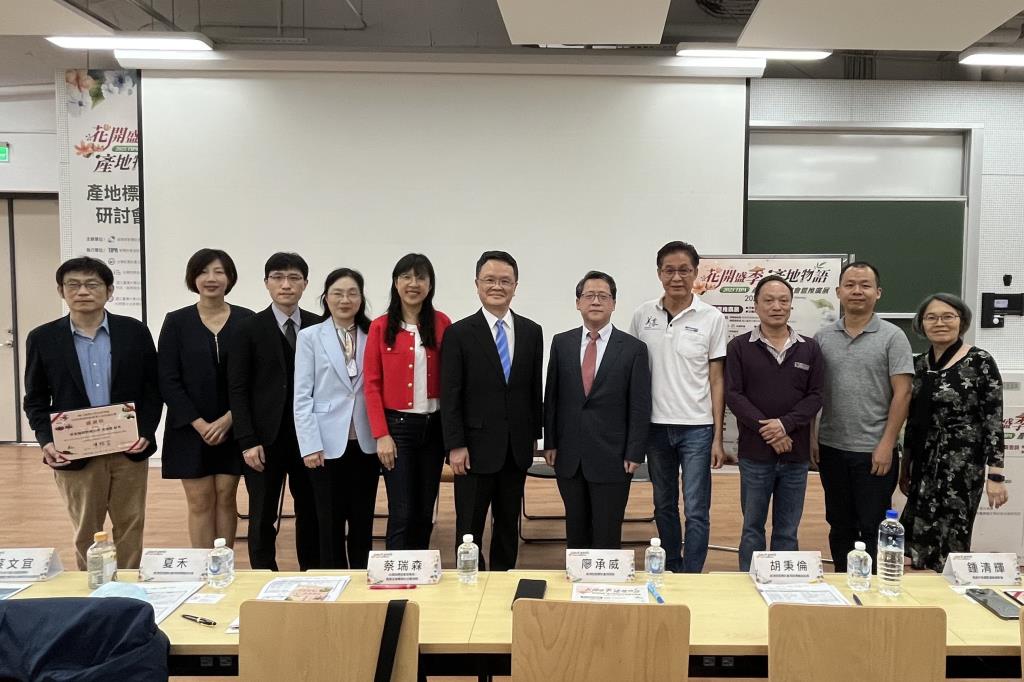 10
102025 TIPA "Origins: Blossoms in Bloom" Graphical Mark Seminar & Promotion Exhibition Concludes Successfully
The 2025 TIPA “Origins: Blossoms in Bloom” Graphical Mark Seminar & Promotion Exhibition, hosted by TIPO, was held on March 15, 2025, at National Taiwan University.At the exhibition, a diverse array of distinctive local agricultural products were showcased, including beans (soybeans, red beans, and black beans) from Meinong, Dong Ding Oolong tea from Lugu, jujubes from Gongguan, rice from Luye, black tea from Sun Moon Lake, taro from Dajia, rice from Chishang, rice from Sanxing, red beans from Wandan, and coffee from Guoxing. Interactive games were also featured on-site to help visitors understand the significance of graphical marks, i.e. graphical certification marks and graphical collective trademarks, and how they promote product quality and regional identity.The afternoon seminar invited scholars and experts—along with graphical mark holders from organizations such as the Meinong Farmers’ Association (Kaohsiung City), Lugu Township Office (Nantou County), Gongguan Farmers’ Association (Miaoli County), and Luye Township Office (Taitung County)—to share practical insights and challenges in promoting graphical marks. The event drew over 170 attendees, generating enthusiastic discussions and engagement.In his opening remarks, TIPO Director General Cheng-Wei Liao emphasized that graphical marks are not only a symbol of origin, but also a promise of quality and integrity. In an increasingly globalized market, clear and trustworthy origin labeling builds consumer confidence. As demand for product traceability and quality assurance grows, graphical marks will continue to play an essential role in shaping market differentiation and trust.Since Chishang Rice registered Taiwan’s first certification mark in 2003, TIPO has continued to promote the graphical mark registration system. To date, 78 valid graphical marks have been registered across Taiwan, covering a variety of agricultural products including rice, tea, and fruit. With the rise of climate change, technological advances in agriculture, and regional revitalization policies, more emerging crops and specialty products are entering the market. TIPO will further collaborate with the Ministry of Agriculture to boost local economies through more small-scale agriculture, which can create more added value. We will continue to offer guidance and consultation services for the registration of graphical marks to support the development of local industries, foster niche advantages, and furnish global competitiveness for Taiwanese agricultural products. 11
11TIPO Welcomes All to the Key Components and Thermal Management Technologies in EVs Seminar at the 360° MOBILITY Mega Shows
In response to the global push for net-zero emissions in the automotive industry, Taiwan is actively advancing its goal of achieving full electrification of transport by 2050. A key part of this strategy involves developing core electric vehicle (EV) components. As EVs become increasingly intelligent and high-performing, thermal management has emerged as a major technical challenge.To support Taiwan's automotive sector with up-to-date patent insights, TIPO conducted a patent trend analysis in 2024 using its patent databases and the Global Patent Search System (GPSS). The study examined patents related to EV thermal management technologies filed between 2014 and 2023, categorized into three key areas: battery cooling, motor cooling, thermal management systems. The results offer a comprehensive look into the global R&D landscape for EV key component's heat dissipation and thermal management technologies.At the invitation of TAITRA, TIPO will present these findings at the 2024 360° MOBILITY Mega Shows. The seminar, titled “Key Components and Thermal Management Technologies in EVs,” will be held on April 24, 2025, at 11:00 AM at TaiNEX 1.TIPO will also participate under the Taiwan Patent GO Pavilion brand, collaborating with the Patent Search Center, the Taiwan Patent Attorneys Association, and the Asian Patent Attorneys Association to provide on-site patent information services to attendees.All those interested in Taiwan’s EV technology development and patent strategy are warmly invited to attend and explore future innovation opportunities!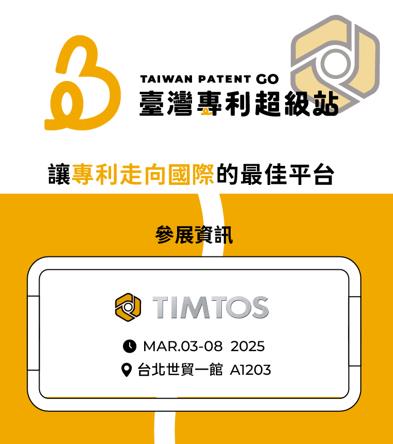 12
12Taiwan Patent GO Showcases Winning Entries of the 2024 National Invention & Creation Awards Starting in March
The 2024 National Invention & Creation Award winners were officially announced on January 20, 2025, on TIPO’s website. This year, from 418 qualified entries, a total of 40 outstanding patented works were selected, including 6 Gold Medals and 26 Silver Medals in the Invention Category, and 4 Gold Medals and 4 Silver Medals in the Creation Category.Among the patent holders of the winning works, 50% are corporations (the highest proportion), 22.5% are foundations, 10% are individuals, 10% are government agencies, and 7.5% are academic institutions.In addition to the awards ceremony scheduled for May–June, TIPO has been actively helping award-winning works gain commercial exposure. Since 2024, TIPO has been curating top-tier patents and exhibiting them at various professional trade shows across Taiwan through the Taiwan Patent GO Pavilion. Leveraging the advantages of networking at trade fairs and international business matchmaking, the Taiwan Patent Go helps companies explore commercialization opportunities.The first Taiwan Patent GO Pavilion of 2025 debuted at TIMTOS (Taipei International Machine Tool Show), co-organized by TAITRA (Taiwan External Trade Development Council) and TAMI (Taiwan Association of Machinery Industry). The event took place from March 3 to 8, 2025, at Taipei World Trade Center Hall 1 (TWTC Hall 1). With over 1,000 exhibitors across 6,100 booths spanning three TWTC exhibition halls, TIMTOS is one of the world’s most prestigious exhibitions for smart manufacturing and machine tools.This Taiwan Patent GO Pavilion will feature five award-winning patented inventions, including Gold Medalists from the 2020 National Invention & Creation Award and Platinum Award winners from the 2022 and 2024 Taiwan Innotech Expo (TIE). TIPO extends its best wishes to the exhibiting patent holders and looks forward to successful networking and business opportunities for all participants.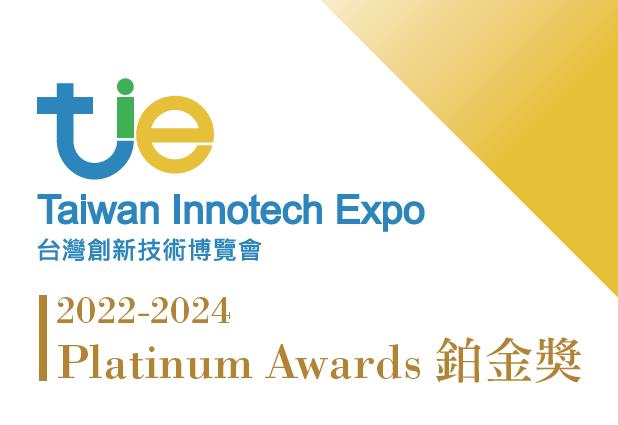 13
132022–2024 Taiwan Innotech Expo (TIE) Platinum Award Compilation Now Available
The 2024 Taiwan Innotech Expo (TIE) successfully concluded on October 19, 2024. This year’s Invention Competition featured 565 participating entries, with only 12 winning the prestigious Platinum Award, resulting in a highly competitive 2% award rate, underscoring the exceptional technological value of the winning innovations.To enhance technology exchange and business matchmaking opportunities for award-winning patent holders, TIPO published the 2022–2024 Taiwan Innotech Expo Platinum Award Compilation, now available on TIPO’s official website. All interested parties are encouraged to explore and engage in potential collaboration opportunities.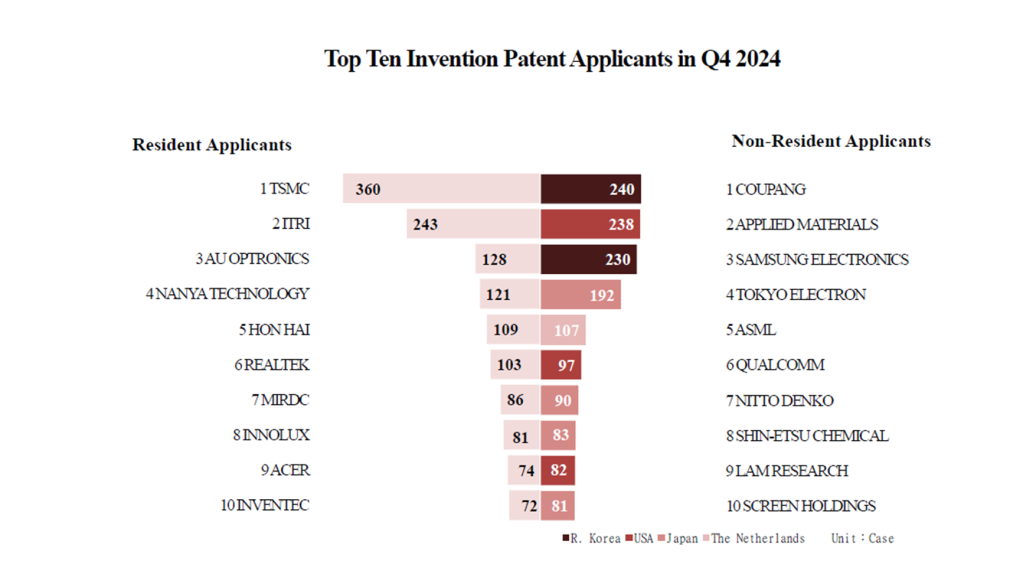 14
14TIPO’s Q4 2024 IPR Statistics Report
I. Overall Trends in Patent and Trademark ApplicationsIn the fourth quarter of 2024, TIPO received a total of 19,977 patent applications, including 14,107 invention patents, 3,888 utility model patents, and 1,982 design patents, marking a 1% increase compared to the same period in 2023 (Figure 1). Among these, the number of invention patents in the fourth quarter has shown a steady increase over the past five years. The proportion of the total number of all three types of patents from both resident and non-resident applicants was roughly equal. Resident applications rose by 4% compared to the previous year, while non-resident applications saw a slight decrease of 1%.A total of 21,401 trademark registration applications (covering 26,961 classes) were filed, showing an 8% decrease compared to the same period last year (Figure 2). Among these applications, 76% were from residents and 24% from non-residents. The number of trademark applications has shown a declining trend in recent years.II. Overview of Patent Applications Filed by ResidentsTop Ten Invention Patent Applicants Resident invention patent applications totaled 5,546, with 4,259 applications filed by enterprises. The top ten applicants for invention patents were led by TSMC, with 360 applications. The others in the top ten included ITRI (243), AU Optronics (128), Nanya Technology (121), Hon Hai (109), Realtek (103), MIRDC (86), Innolux (81), Acer (74), and Inventec (72) (Figure 4). Notably, TSMC has ranked first for two consecutive years since the fourth quarter of 2023, while Hon Hai saw a remarkable 160% increase in applications compared to the previous year.Top Five Design Patent Applicants Resident design patent applications totaled 938, with the top five applicants led by L&F Plastics, which filed 43 applications. The other top applicants included B'In Music (24), Godmiracle (19), Matsushita Electric (14), and Coplus (13) (Figure 5). Notably, B'In Music and Godmiracle entered the top five for the first time, highlighting their focus on design innovation.Overview of Patent Applications Filed by Non-ResidentsFiling Countries (Regions) of Invention Patent Applicants Non-resident invention patent applications totaled 8,561, with the top five countries/regions led by Japan, which filed 3,194 applications. The other top countries/regions included the US (1,837), R. Korea (1,100), mainland China (1,009), and Germany (303) (Figure 3). Among these, Japan and R. Korea have experienced positive growth for two consecutive years. Particularly, R. Korea has seen growth rates of 16% and 14% over the past two years, demonstrating a highly active patent strategy in Taiwan.Top Ten Invention Patent ApplicantsAmong the top ten non-resident applicants for invention patents, Coupang from R. Korea ranked first with 240 applications, followed by the Applied Materials (238) from the US, Samsung Electronics (230) from R. Korea, Tokyo Electron (192) from Japan, ASML (107) from the Netherlands, Qualcomm (97) from the US, Nitto Denko (90) from Japan, Shin-Etsu Chemical (83) from Japan, Lam Research (82) from the US, and Screen Holdings (81) from Japan (Figure 4). Coupang, Tokyo Electron, and Shin-Etsu Chemical reached record application numbers, with Coupang becoming the top non-resident applicant for the first time. This highlights Taiwan’s importance as a hub for semiconductor R&D and innovation, as well as its appeal for cross-border e-commerce.Filing Countries (Regions) of Design Patent ApplicantsNon-resident design patent applications totaled 1,044, with the top five countries/regions led by mainland China, which filed 221 applications. The other top countries/regions included Japan (198), the US (175), Switzerland (106), and Italy (68) (Figure 3). Notably, mainland China surpassed Japan and the US this quarter, ranking first.Top Five Design Patent ApplicantsAmong the top non-resident applicants for design patents, Gessi from Italy led with 40 applications, followed by the Apple from the US, Harry Winston from Switzerland, and Zhejiang Geely Holding from mainland China, each with 36 applications, and Ford Global Technologies (31) from the US (Figure 5). Notably, Gessi and Zhejiang Geely Holding reached new highs in the number of applications, demonstrating their strong focus on the Taiwan market and active investment in protecting their unique product designs.Overview of Trademark Registration ApplicationsTop Ten Resident Applicants for TrademarksResident trademark registration applications totaled 16,174, with the top ten applicants led by Momo.com, which filed 140 applications. The other top applicants included Gongtian Temple (104), Uni-President (82), Chin Yee Chemical (45), Lungyen Life (40), the ITRI (39), Xu, Yu-Jie (33), Wowprime (32), TaoYuan Long-De Temple (32), and TCI (29) (Table 1).NICE Classification of Resident ApplicationsThe top three categories of resident trademark applications are as follows: Class 35 (advertising, business management, retail and wholesale services, etc.) with 3,174 applications, Class 43 (restaurants, lodgings, etc.) (1,545), and Class 30 (coffee, tea, pastries, etc.) (1,307) (Figure 7). This indicates that resident applicants primarily focus on business management, consumer-related services such as restaurants and accommodations, and products like coffee and pastries.Filing Countries (Regions) of Non-Resident ApplicationsNon-resident trademark registration applications totaled 5,227, with the top five countries/regions led by mainland China, which filed 1,363 applications. The other top countries/regions included Japan (919), the US (729), R. Korea (492), and Hong Kong (267) (Figure 6). Except for the US, the other four countries/regions showed positive growth in their application numbers.Top Ten Non-Resident Applicants for TrademarksAmong Non-resident trademark applicants, the top applicant was Huang Cheng-Fang from mainland China, with 72 applications. The other top applicants were Toyota Jidosha (38) from Japan, Tencent Holdings (35) from the Cayman Islands, Kao (23) from Japan, Procter & Gamble (22) from the US, Celgene (21) from the US, and Bayer from Germany, Target Brands from the US, Kobayashi Pharmaceutical from Japan, and CompanionAI Networks from Singapore, each with 18 applications (Table 2).NICE Classification of Non-Resident ApplicationsThe top three categories of non-resident trademark applications are as follows: Class 9 (computer and technology products, etc.) with 952 applications, Class 35 (advertising, business management, retail and wholesale services, etc.) (652), and Class 3 (cosmetics, detergents, etc.) (583) (Figure 8). Non-resident applicants primarily focused on registering trademarks for computer and technology products (Class 9) in Taiwan, while applications in cosmetics and detergents (Class 3) have been growing rapidly.Analysis of Applications by IndustryThe top industries for trademark applications were "Agriculture" with 5,427 applications, followed by "Health" (4,483) and "Business Services" (4,311).The top three industries for trademark applications are as follows: For resident applicants, "Agriculture" led with 4,329 applications, primarily from trademark applications related to restaurants and accommodations. For non-resident applicants, "Research and Technology" topped the list with 1,488 applications (Figure 9). Additionally, there is a growing number of non-resident trademark applications in both "Health" and "Agriculture."Note: The above statistical analysis for type of applicant and applicant nationality is based on the first applicant.Reference URL: https://www.tipo.gov.tw/en/lp-302-2.html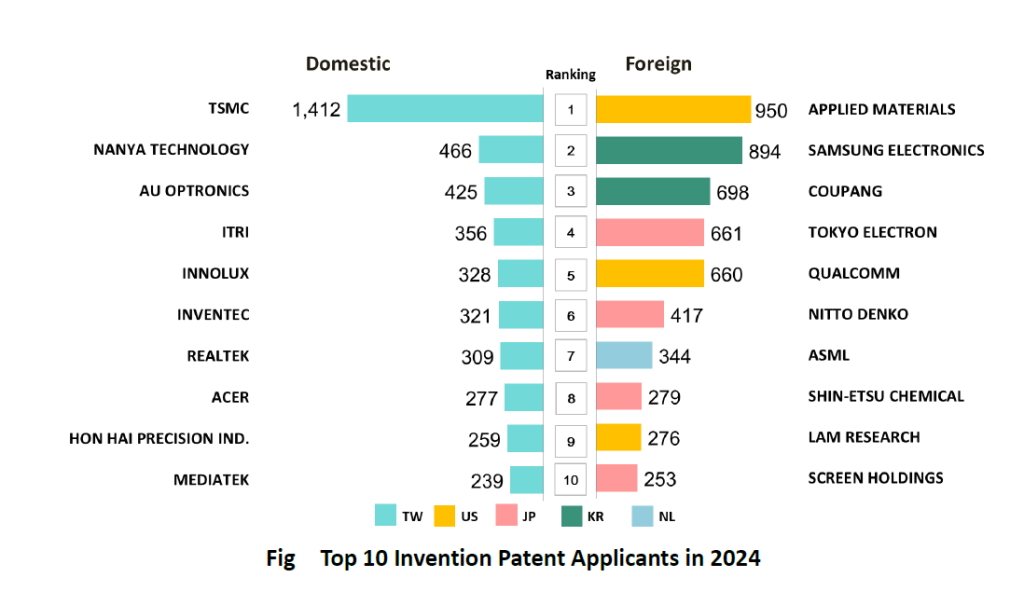 15
15Top 100 Patent Applicants in 2024
In TIPO’s 2024 Statistical Rankings for Patent Applications and Grants, TSMC maintained its position as the top domestic invention patent applicant for the ninth consecutive year, filing 1,412 applications. As for foreign applicants, US-based Applied Materials returned to the top spot with a total of 950 applications. With 356 invention applications, the Industrial Technology Research Institute (ITRI) outstripped all other research institutions. Among university applicants, National Cheng Kung University filed the most invention patent applications (121). With respect to overall patent grants, TSMC led domestic applications with 1,163 grants, and Applied Materials was the most prolific foreign applicant with 697 grants.TSMC Ranks as Top Domestic Invention Patent Applicant for the Ninth Year StraightFor the ninth consecutive year, TSMC led domestic applications with 1,412 invention patent applications in 2024. Nanya Tech (466) followed in second place, trailed by AU Optronics (425), ITRI (356), Innolux (328), Inventec (321), Realtek (309), Acer (277), Hon Hai Precision Industry (259), and Mediatek (239). Among the top ten domestic applicants, Nanya Tech and Innolux hit new records, while Hon Hai Precision Industry exhibited the fastest growth rate at 93% (Fig, Table 1).Among the top 20 domestic applicants, United Microelectronics (ranking 12th with 221 applications), Winbond Electronics (ranking 13th with 160) and Powerchip Semiconductor Manufacturing Corp (ranking 17th with 131) also gained their all-time highs (Table 1).Applied Materials returned to the top spot among foreign invention patent applicantsOn the foreign applicant front, US-based Applied Materials reclaimed the top spot with 950 applications in 2024, followed by Samsung Electronics of the Republic of Korea (894), Korea-based Coupang (698), Japan-based Tokyo Electron (661), US-based Qualcomm (660), Japan-based Nitto Denko (417), ASML Netherlands (344), Shin-Etsu Chemical (279), US-based Lam Research (276), and Screen Holdings (253). Among the top 10 foreign applicants, the sharpest increase in 2024 was for Coupang (+54%). Furthermore, Coupang, Tokyo Electron, ASML Netherlands, Shin-Etsu Chemical, and Lam Research all posted record high overall applications (Fig, Table 2).Among the top 20 foreign applicants list in 2024, Japan led with 11 applicants. Additionally, Resonac (ranking 11th with 251 applications), Huawei Technologies (ranking 17th with 184 applications) and Wonderland Switzerland (ranking 18th with 167 applications) also hit all-time highs (Table 2).ITRI Remains Top Invention Patent Applicant for 18 Years Running, While National Cheng Kung University Leads Among University Applicants for Third Year StraightFive research institutes also ranked among the top 100 domestic invention patent applicants in 2024. The Industrial Technology Research Institute (ITRI) placed 4th with 356 applications, maintaining its top position among research institutes for the 18th consecutive year (Table 3).Twenty-one schools were among the top 100 domestic invention patent applicants in 2024. National Cheng Kung University (121) claimed the first spot, followed by National Taiwan University (98), National Tsing Hua University (83), National Chin-Yi University of Technology (75), National Yang Ming Chiao Tung University (74), National Pingtung University of Science (60), National Taipei University of Technology (55), National Sun Yat-Sen University (51), National Taiwan University of Science And Technology (49), and National Chung Hsing University (48). Notably, Taipei Medical University (ranking 11th with 47 applications) emerged at the top among private universities (Table 4).The trend in design patent applications in 2024, Chang Gung University of Science and Technology led with 51 cases, followed by Shu Te University (34). In respect of overall patent applicants, Taipei City University of Science and Technology ranked first among schools with 177 applications (most of which are utility model applications) for the 5th straight year (Table 5).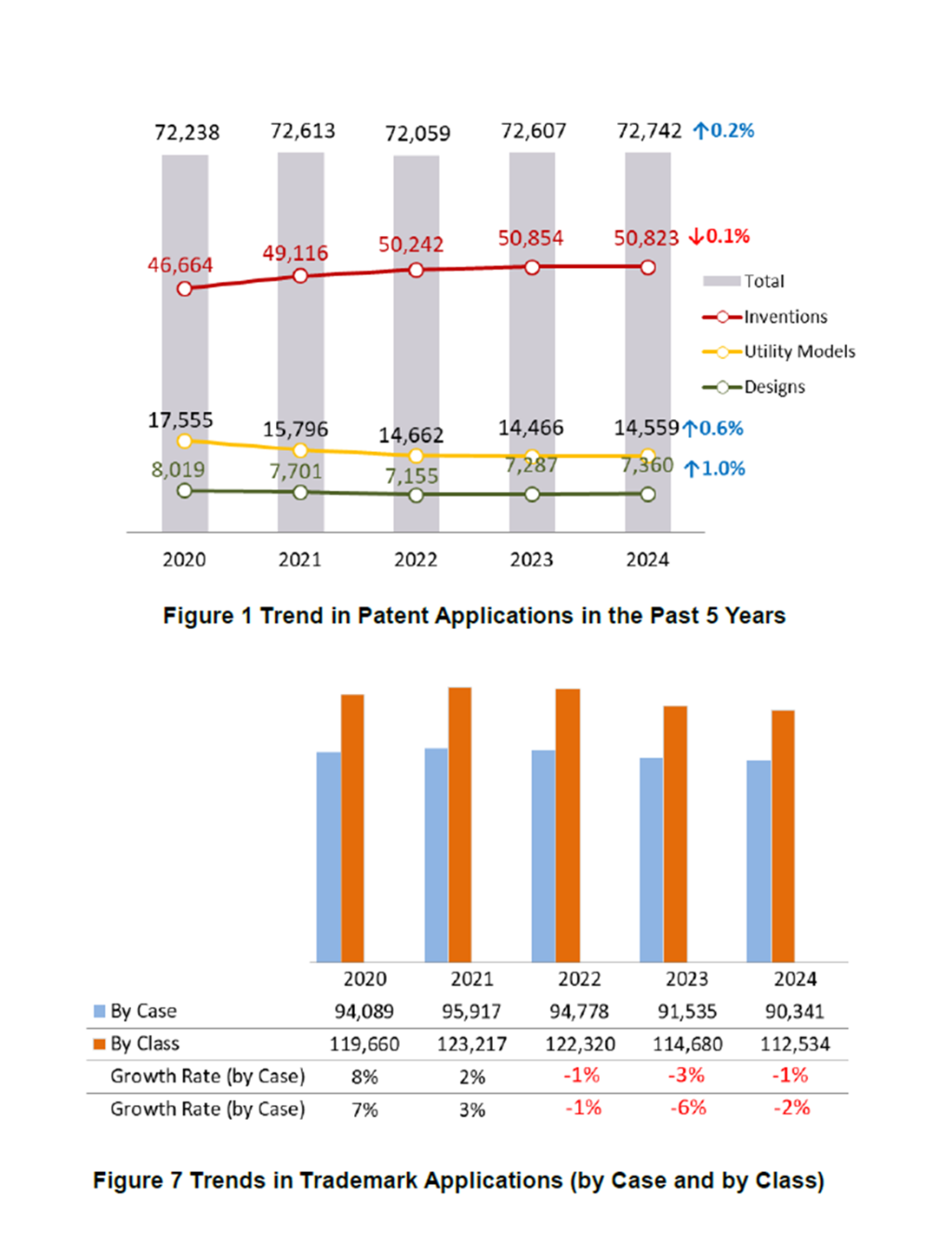 16
16TIPO Statistics Report: Patent and Trademark Applications in 2024
In 2024, TIPO received a total of 72,742 patent applications, roughly the same as 2023. Of these, invention patents (50,823) experienced a slight decrease, utility model patents (14,559) experienced a positive turnaround, while design patents (7,360) continued growing. Trademark applications (90,341) experienced a slowed decrease. As to examination efficiency, the average first action pendency was 8.4 months for invention patent applications and 6.1 months for trademark applications.Invention and Utility Model Applications from Domestic Industries Show Diverse Patent Portfolios, While Those From Domestic Universities and Research Institutes SurgeDomestically, in 2024, invention patent applications (19,586) decreased by 0.2%, while utility model applications (13,341) increased slightly by 0.2%. By applicant type, invention patent applications decreased by 1% but utility model applications increased by 3% for domestic industries, showing diverse patent portfolio strategies. Invention patent applications from domestic universities and research institutes surged by 3-8%, and utility model applications by 13-57%. Design applications (3,338) were down by 3%, mainly due to decreases in filings from universities, while those from enterprises rose by 5% (Table 1, Figure 2, Figure 3).Japan Leads in Foreign Invention and Design Patent ApplicationsForeign invention patent applications (31,237) rose by a slight 0.1% in 2024. A breakdown by applicant nationality shows Japan maintaining its lead with 12,307 applications, followed by the US (6,817), Mainland China (3,472), the Republic of Korea (3,365), and Germany (1,035), among which R. Korea reached a record high. Furthermore, R. Korea and Germany had the fastest growth rate of 8% among the top 5 countries (regions), while the US also rose by 1%. However, Japan and Mainland China fell by 2% and 9%, respectively. (Table 1, Figure 4).Non-resident applications for design patents increased by 4% to 4,022 applications in 2024. Japan also topped the list of countries filing design patents in Taiwan with 880 applications, followed by the US (772) and Mainland China (755), Switzerland (370), and Germany (241). Among the top 5 countries (regions), Mainland China saw a sharp increase of 61%, while Germany rose by 1%. However, Japan, the US, and Switzerland all fell by 6% (Table 1, Figure 5).Trademark Applications See Smaller Decrease of 1%The number of trademark applications stood at 90,341 (covering 112,534 classes – a 2% decrease from the previous year) in 2024, marking a decrease by 1%, smaller than the drop (-3%) in 2023. Notably, there was a 4% decrease in resident applications (69,386), while non-resident applications experienced a turnaround by rising 7% (20,955) (Table 1, Figure 7, Figure 8).Among the top 5 trademark-filing countries (regions), mainland China (5,624) took the lead, followed by Japan (3,397), the US (2,822), R. Korea (1,919) and Hong Kong (1,227). Among the top 5 countries (regions), the US was down by 3%, while others saw an impressive growth of 13-28% (Figure 9).UNI-PRESIDENT Ranks as Top Resident Trademark Applicant for Sixth Year Straight, While TENCENT HOLDINGS Leads Among Non-ResidentsFor the sixth year in a row, Uni-President remained as the top resident trademark applicant with 709 applications in 2024. MOMO.COM (216) follows in second, while Wu, Ruo-Mei (163) and the other top 5 applicants filed trademarks in or related to religious temples. With regard to non-resident applicants, Tencent Holdings of Cayman Islands continued to take the lead with 146 applications, followed by L'Oreal of France (86) and Kao of Japan (81) (Figure 10).Resident trademark applications were mostly filed in Class 35 (Advertising; business management) (13,407). Among the top 10 classes, Class 3 (Cosmetics and toiletry preparations), Class 5 (Pharmaceuticals) and Class 42 (Scientific and technological services) had growth rates of between -0.3% (negative growth) and 2.2%, while other classes decreased at rates between 1.8% to 10.6% (Table 2).Most non-resident trademark applications were filed in Class 9 (computer and technology) (3,848). Among the top 10 classes, Class 3 (Cosmetics and toiletry preparations), Class 25 (Clothing, footwear, headwear) and Class 18 (Leather and imitations of leathers, luggage) all saw double-digit growth between 12.2-15.4%, while Class 5 (Pharmaceuticals) and Class 42 (Scientific and technological services) fell by 3.7% and 9.8% respectively (Table 2).Optimized Patent and Trademark Examination Pendency Facilitates Industry PortfoliosTIPO is dedicated to optimizing patent and trademark examination quality and efficiency to support industries by expediting the grant process and building their portfolio. As a result, the average first action pendency was 8.4 months for invention patent applications in 2024, down by 0.5 months compared to 2023. The number for pending applications was 52,712 (Figure 6). For trademark applications, the average first action pendency was 6.1 months, shortened by 0.1 month. The number for pending applications fell to 52,860 (Figure 11). 17
17TIPO Publishes 2025.01 Edition of International Patent Classification Information
The information for the 2025.01 edition of the International Patent Classification (IPC) has been published on TIPO’s official website. Starting February 5, 2025, TIPO will adopt the new edition (2025.01) for classifying newly filed patent applications. Consequently, the Patent Gazette will reflect the updated classification starting from the March 11, 2025 issue, and the Invention Publication Gazette will adopt the new classification from the April 16, 2025 issue. 18
182024 Interview Series on Outstanding Female Leaders in the Field of IP in Taiwan
To highlight the achievements and career development of female professionals in Taiwan's IP sector, TIPO has launched the "2024 Interview Series on Outstanding Female Leaders in the Field of IP in Taiwan." This series features interviews with four distinguished women in the IP field: Billie Chen, Associate General Counsel at TSMC, Chih-Chieh Lin, Professor at National Yang Ming Chiao Tung University, Pei-Chun Chen, Chief Technology Officer at Microsoft AI R&D Center, and Hsiu-Ru Chien, Partner at Lee and Li Attorneys-at-Law.TIPO hopes that the 2024 Interview Series on Outstanding Female Leaders in the Field of IP in Taiwan will continue to serve as a source of inspiration, encouraging more women to pursue careers in the field of IP and break down gender barriers.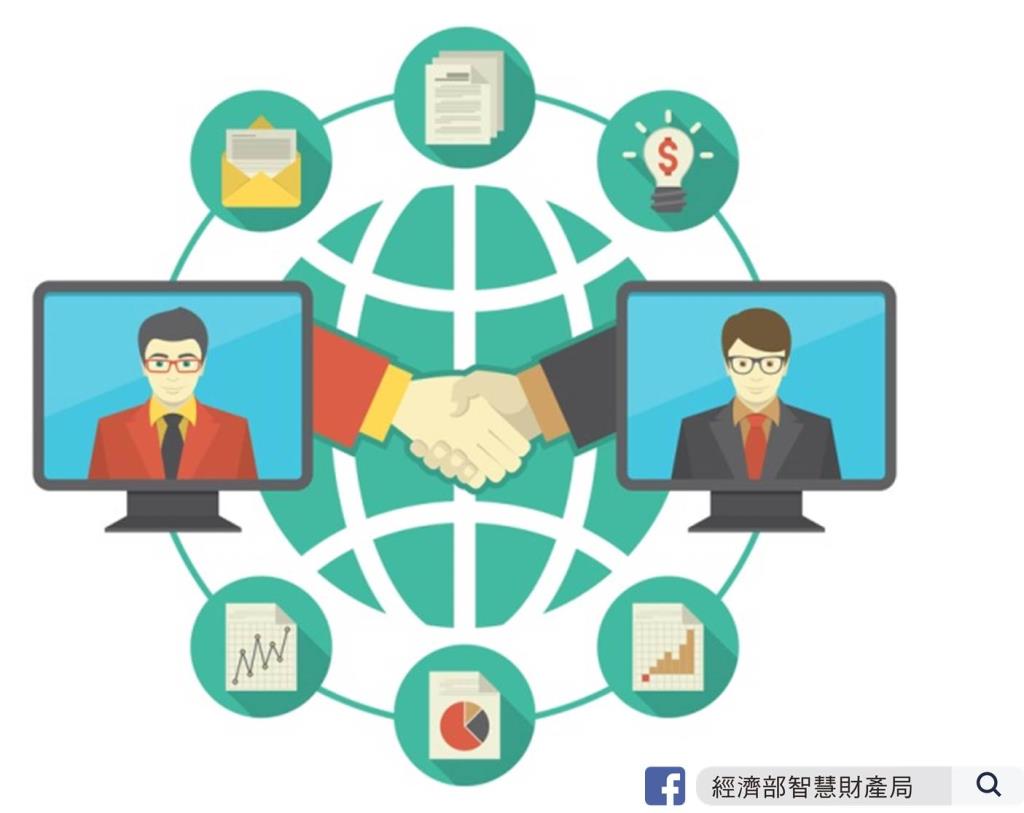 19
19Industry Collaborative Patent Interview Pilot Program Extended to December 31, 2026
The Industry Collaborative Patent Interview Pilot Program, launched in 2023, was initially set to expire on January 2, 2025. To address applicants' need for expedited patent approval and to support the development of their patent portfolios, TIPO has extended the pilot program through December 31, 2026. 20
20TIPO Releases Report on "Patent Trend Analysis for Key Components in the Electric Vehicle Industry"
To achieve the goal of transitioning to fully electrified transportation by 2050, Taiwan has been actively promoting policies for developing key components of the electric vehicle industry. As electric vehicles continue to evolve toward greater intelligence and higher performance, thermal management and cooling technologies have emerged as critical challenges.On December 2, 2024, TIPO published the "Patent Trend Analysis for Key Components in the Electric Vehicle Industry" report. The report focuses on the automotive industry's response to net-zero carbon emissions and electrification, analyzing patents related to electric vehicle cooling technologies from 2014 to 2023. It categorizes these patents into three main areas: battery cooling, motor cooling, and thermal management systems. Additionally, the report highlights patent trends and shares specific examples within these categories. The report is now available for reference.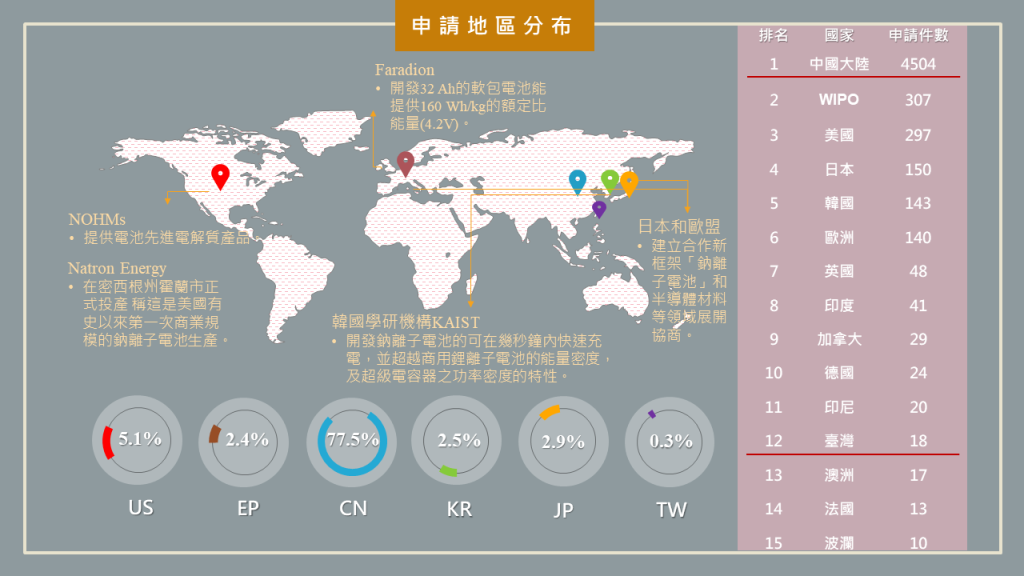 21
21Patent Search Center Releases Two Reports: "Patent Landscape Analysis of 5G and AIoT Integrated Applications" & "Patent Technology Analysis of Sodium-Ion Batteries"
Amid the global trends of achieving net-zero emissions and advancing digital transformation, the development of 5G and AIoT technologies, as well as sodium-ion battery innovations, have become critical focal points. Commissioned by TIPO, the Patent Search Center has completed two patent analysis reports: "Patent Landscape Analysis of 5G and AIoT Integrated Applications" and "Patent Technology Analysis of Sodium-Ion Batteries" - the former examines patent developments related to sensor nodes and network architecture technologies, while the latter provides a comprehensive analysis of patent trends and industrial applications for battery cell materials.These reports aim to provide valuable references for governments and businesses to formulate technology development strategies, plan for future market opportunities, and enhance Taiwan’s competitiveness within the global value chain.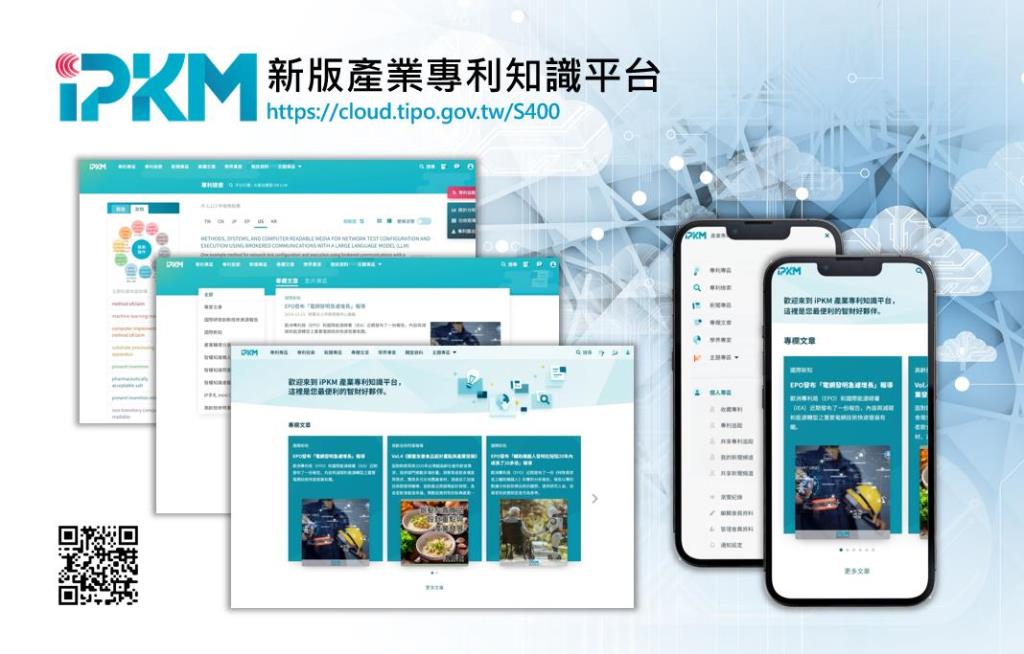 22
22TIPO Launches "Industry Patent Knowledge Platform" Service on the "IP Info Cloud"
In alignment with the government’s cloud policy and to enhance service quality for the public, TIPO has been developing the IP Info Cloud since 2021. Utilizing public cloud infrastructure, this initiative aims to establish a cloud-based service platform with high availability and scalability. As part of this effort, the Industry Patent Knowledge Platform website was successfully migrated to the cloud in 2024 and is now available for trial use.The platform's user interface has been optimized to unify the desktop and mobile versions, supporting seamless browsing across devices such as computers, tablets, and smartphones. Users can easily access resources such as patent documents, expert articles, the latest IP news, information on patent systems from various countries, and insights from academic experts. TIPO welcomes continued support and feedback from users. 23
23TIPO Announces Revised “Positive Patent Examination Pilot Program for Startup Companies”
To enable eligible startup companies that have received national awards or participated in TIPO-sponsored programs to obtain patents within four months of application, thereby strengthening their competitive edge in the industry, TIPO has revised the "Positive Patent Examination Pilot Program for Startup Companies." The eligibility criteria have been expanded from startups established for less than eight years to also include companies with innovative R&D capabilities that have received national awards within the past two years and companies guided by organizations commissioned by TIPO. The revised program took effect on January 1, 2025.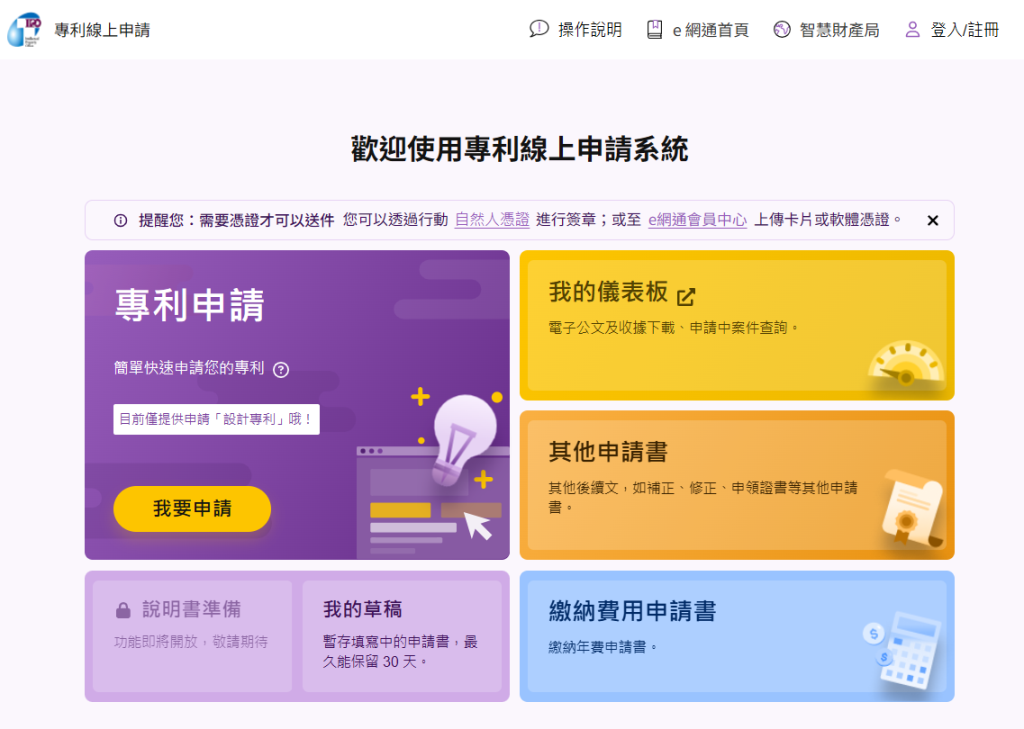 24
24TIPO Launches the Design Patent Online Application System – Now Open to the Public for New Design Patent and Derivative Design Applications!
To streamline online patent applications, TIPO has introduced a brand-new, web-based Design Patent Online Application System. Starting in 2024, the system offers a wide range of features, including new applications, re-examinations, amendments, submissions, issuances, annuity fee payments, making responses, withdrawals, postponements, and assignments related to design patents and derivative design patents.Users no longer need to install standalone tools, as the system is accessible directly through a browser and supports cross-device functionality. 25
25Trial Period for the "Accelerated Examination Pilot Program for Design Patents" Extended by Two Years
To provide more diverse and flexible examination options for design patent applications, TIPO launched the "Accelerated Examination Pilot Program for Design Patents" on September 1, 2023. Initially set to run until December 31, 2024, the program has now been extended through December 31, 2026. A further evaluation will determine whether to continue or modify the program. The details of the program are as follows:1. Application Timing: Applicants may file for accelerated examination for design patents after receiving TIPO’s notification that the preliminary examination is about to begin and before receiving the first Office Action.2. Application Process: Applicants must file electronically in accordance with TIPO’s regulations and provide relevant supporting documents. During the trial period, no application fee will be charged for this program.3. Eligibility Criteria:(1) Criterion 1: Third-Party Commercial ExploitationApplicants must submit documentation proving third-party commercial exploitation (e.g., product catalogs, newspaper, or magazine articles) and specify the third party’s details, the nature of the exploitation, and its starting date.(2) Criterion 2: Recognition by Prestigious Design AwardsApplicants must provide certificates and evidence of the awarded design corresponding to the applicant's name. Eligible awards include:Taiwan's Golden Pin Design AwardGermany's iF Design AwardGermany's Red Dot Design AwardJapan's Good Design AwardThe United States' International Design Excellence Awards (IDEA)(3) Criterion 3: Design Patent Applications by StartupsEach startup is limited to three applications per year under this program. Eligible startups must be companies established for less than eight years under the Company Act or equivalent foreign laws. The establishment period is calculated from the company’s registration date to the design patent application date. If priority is claimed, the calculation is based on the earliest priority date.For foreign companies, proof of the establishment date must be provided along with a Chinese translation. If the document is not an original, a declaration must be submitted.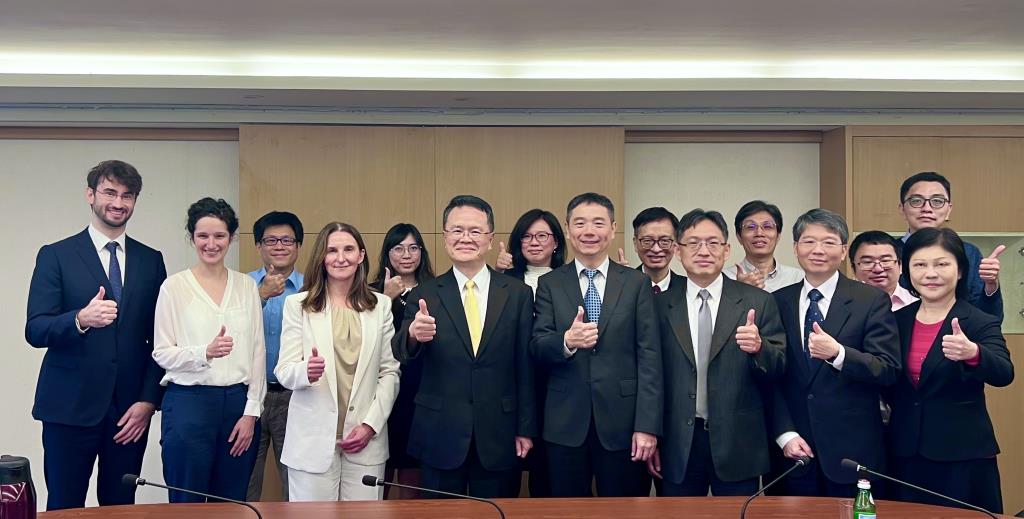 26
26The 4th Canada-Taiwan IP Policy Dialogue was successfully held in Taipei
The 4th Canada-Taiwan Intellectual Property Policy Dialogue was held in Taipei on 3 December 2024.Both sides exchanged opinions on and discussed the following topics: Experience and Outcomes in Digital Transformation; Patent Grace Period; and Promoting IP Awareness.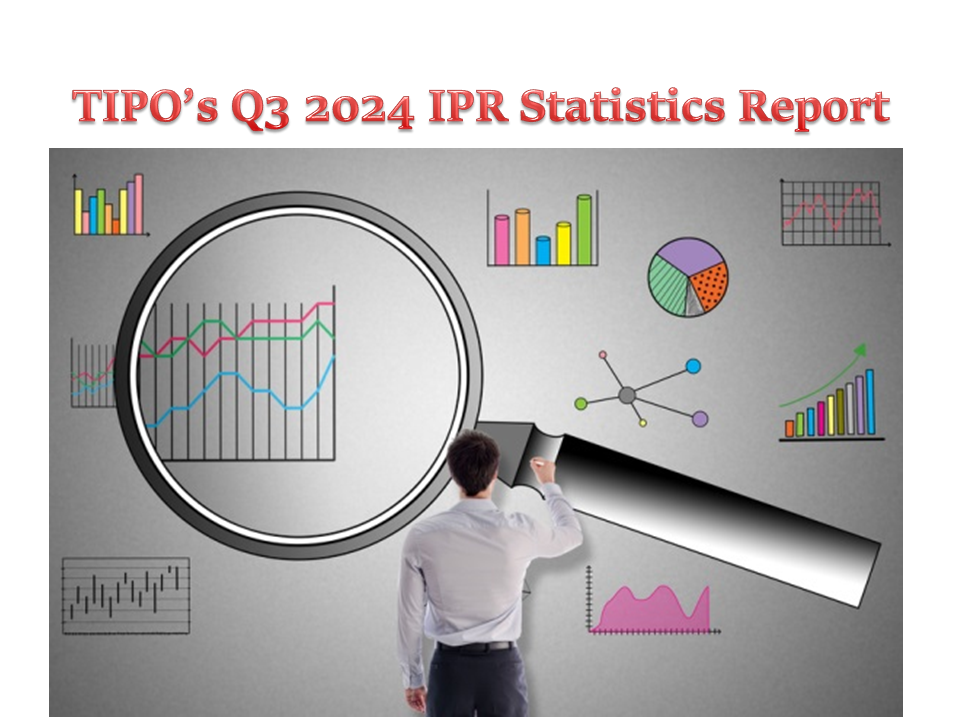 27
27TIPO’s Q3 2024 IPR Statistics Report
I. Overall Trends in Patent and Trademark ApplicationsIn the third quarter of 2024, TIPO received a total of 18,267 patent applications across three categories: 12,739 for invention patents, 3,679 for utility model patents, and 1,849 for design patents, representing a slight 0.2% decrease compared to the same period in 2023. Notably, invention patent applications have exhibited a gradual upward trend over the past five years during the third quarter. Resident applicants accounted for 49% of the total patent applications, while non-resident applicants contributed 51%. Compared to the previous year, applications from resident applicants decreased by 2%, whereas those from non-resident applicants increased by 2% (Figure 1).In the third quarter of 2024, a total of 23,304 trademark applications (covering 29,258 classes) were filed, representing a 1% decrease compared to the same period last year. Among these, resident applicants accounted for 77% and non-resident applicants for 23%. Over the past two years, trademark applications during the third quarter have shown a downward trend, with this year’s decline narrowing to 1% (Figure 2).II. Overview of Patent Applications Filed by ResidentsTop Ten Invention Patent ApplicantsResidents filed 4,857 invention patent applications, with enterprises accounting for 3,881 of these applications. Among the top ten applicants, TSMC ranked first with 331 applications, followed by AU Optronics (99), Inventec (94), Nanya Technology (88), Innolux (84), Delta (81), Hon Hai (76), UMC (75), Realtek (73), and MediaTek (66)(Figure 4). It is worth noting that TSMC has maintained the top position for nine consecutive years since the third quarter of 2016. Delta achieved a record high number of applications, while Hon Hai showed rapid growth, indicating their strategic intent in patent portfolio development.Top Five Design Patent ApplicantsResident applicants filed 790 design patent applications. Among the top five applicants, Tarng Yu led with 16 applications, followed by CGUST and Hsien Chang Optical (both 13). Acer and L&F Plastics ranked next (both 12)(Figure 5). Among them, Hsien Chang Optical set a new record for the number of applications filed, as well as for its own ranking.Overview of Patent Applications Filed by Non-ResidentsFiling Countries (Regions) of Invention Patent ApplicantsNon-residents filed 7,882 invention patent applications. The top five countries (or regions) were Japan with 3,058 applications, followed by the US (1,724), mainland China (898), R. Korea (872), and Germany (252)(Figure 3). In particular, applications from R. Korea have gradually increased, indicating its growing emphasis on strengthening patent portfolios in Taiwan.Top Ten Invention Patent ApplicantsAmong the top ten non-resident applicants for invention patents, Applied Materials from the US filed 254 applications, regaining the top position. It was followed by Samsung Electronics (222) from R. Korea, Qualcomm (202) from the US, Coupang from R. Korea and Tokyo Electron from Japan (both 175), Nitto Denko (101) from Japan, Fujifilm (91) from Japan, ASML (90) from the Netherlands, Kioxia (83) from Japan, and Resonac (71) from Japan (Figure 4). Notably, both Applied Materials and Tokyo Electron achieved record-high filing numbers.Filing Countries (Regions) of Design Patent ApplicantsNon-resident applicants filed 1,059 design patent applications. The top five countries (or regions) were Japan, leading with 221 applications, followed closely by the US (220), mainland China (210), Germany (83), and Switzerland (76) (Figure 3). Significantly, the US was nearly on par with Japan in filing numbers, while mainland China trailed closely behind.Top Five Design Patent ApplicantsAmong the top five non-resident applicants for design patents, Apple (US) led with 50 applications. It was followed by Beijing Roborock from mainland China and BMW from Germany (both 40), China Wonderland (27) from mainland China, and Ford Global Technologies (25) from the US (Figure 5). Notably, Apple retained its leading position, reflecting its strategy of protecting new products through design patents, while Beijing Roborock achieved a record-high number of filings.Overview of Trademark Registration ApplicationsTop Ten Resident Applicants for TrademarksResident applicants filed 17,962 trademark registration applications. Among the top ten applicants, Uni-President ranked first with 236 applications, followed by Bao-Hu Temple Tian-Di Hall (106), Wu, Ruo-Mei (103), Chunghwa Telecom (84), Go Far (78), R&R Medical (67), Cathay Financial Holdings (60), Cathay Life Insurance (55), Microjet Technology (50), and Gamania Digital (44)(Table 1).NICE Classification of Resident ApplicationsThe top three trademark application categories filed by resident applicants were as follows: Class 35 (advertising, business management, retail and wholesale services, etc.) with 3,496 applications, Class 43 (restaurants, lodgings, etc.) (1,629), and Class 30 (coffee, tea, pastries, etc.) (1,481) (Figure 7). This indicates that trademark filings in Taiwan are primarily concentrated in areas related to business operations, consumer services such as hotel and dining, and consumer foods like coffee and pastries.Filing Countries (Regions) of Non-Resident ApplicationsNon-resident applicants filed 5,342 trademark registration applications. The top five countries (or regions) were mainland China, with 1,472 applications, followed by Japan (837), the US (693), R. Korea (540), and Hong Kong (317) (Figure 6). Except for the US, the number of applications from the other four countries (or regions) increased by 15% to 47%.Top Ten Non-Resident Applicants for Trademarks The top ten non-resident applicants for trademark registration were led by Hong Kong's CUYI with 50 applications, followed by Beijing Roborock (44) from mainland China, Boehringer Ingelheim (39) from Germany, Tencent (37) from Cayman Islands, Shizutetsu (34) from Japan, Frasers Property from Singapore and Beijing Jingdong from mainland China (both 32), L'Oreal (28) from France, and LG H&H and HanGo from R. Korea (both 24) (Table 2). NICE Classification of Non-Resident ApplicationsThe top three trademark application categories filed by non-resident applicants were as follows: Class 9 (computers and technology products, etc.) with 985 applications, Class 35 (advertising, business management, retail and wholesale services, etc.) (589), and Class 3 (cosmetics and detergents, etc.) (579) (Figure 8). Non-resident applicants primarily focused on trademark registration for computer and technology products under Class 9.Analysis of Applications by IndustryMost trademark applications were classified under “Agriculture” with 5,844 applications, followed by "Health" (4,810), and "Business Services" (4,628) (Figure 9).Among the top three industries for trademark applications, resident applicants are concentrated in "Agriculture" with 4,714 cases, primarily for trademarks related to restaurants and accommodations. Non-resident applicants have the highest number in "Research and Technology" with 1,514 cases (Figure 9). Additionally, resident applicants saw a 2% increase in filings under the "Health" category, while non-resident applicants experienced a 22% increase in filings under the "Agriculture" category, with both showing growth.Note: The above statistical data is based on the “first applicant” of the applications when referencing applicants and nationalities.Reference URL: https://www.tipo.gov.tw/en/lp-302-2.html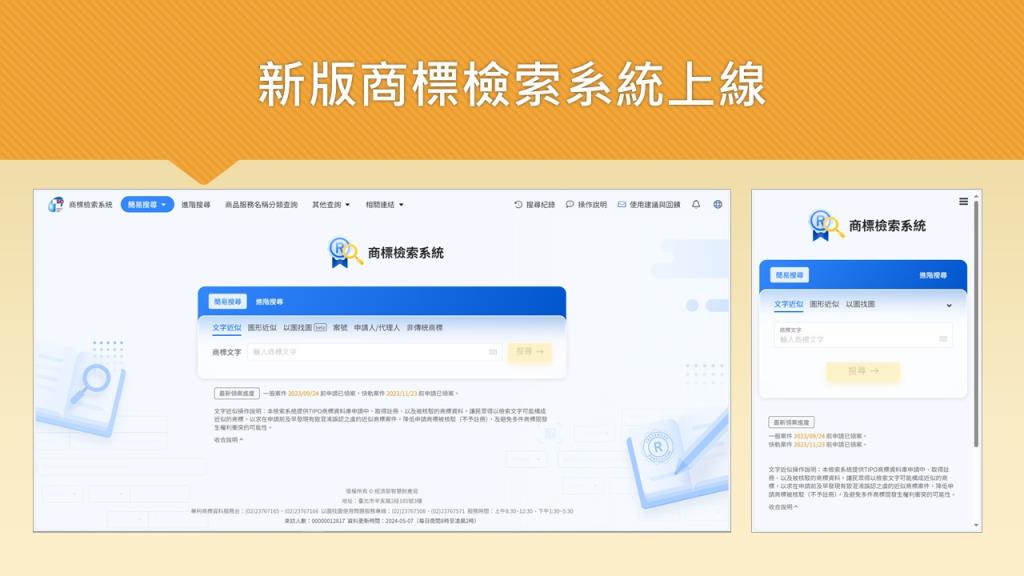 28
28TIPO Launches New Trademark Search System
To improve usability and support mobile browsing, TIPO has launched a new Trademark Search System with simplified and advanced search features to meet the needs of different users. The new system also increases the number of displayed search results to 1,000 entries, reducing the need to repeatedly narrow search criteria.The old system will no longer be available from March 2025. Users are encouraged to switch to the new system.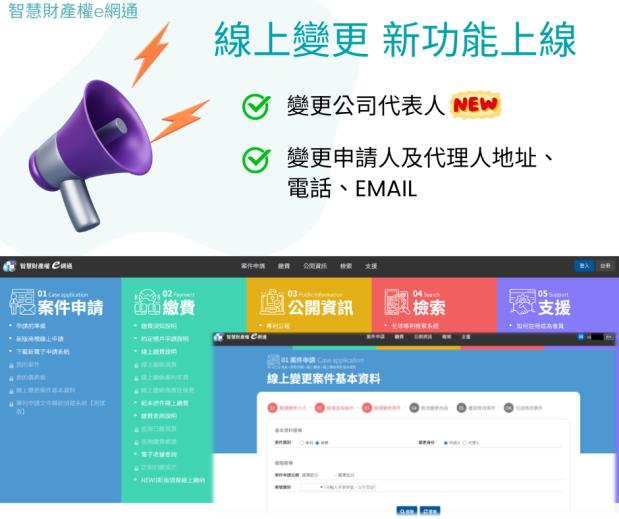 29
29TIPONet Expands Online Services for Changing Applicants’ Representatives
To facilitate changes for patent and trademark applicants and reduce the need for administrative correspondence between applicants and TIPO, TIPO has expanded the online services available through TIPONet. Starting October 15, 2024, applicants can now use the platform to change their representatives. After logging in to TIPONet, applicants or their patent agent can select the "Applying for a patent/Changing Online" feature to modify basic case information, including:1. The name of the applicant’s representative in Chinese and English.2. The applicant and their patent agent’s address in Chinese and English, phone number, and email address.For assistance with technical issues, please contact the TIPONet Customer Service Line or Email: [email protected].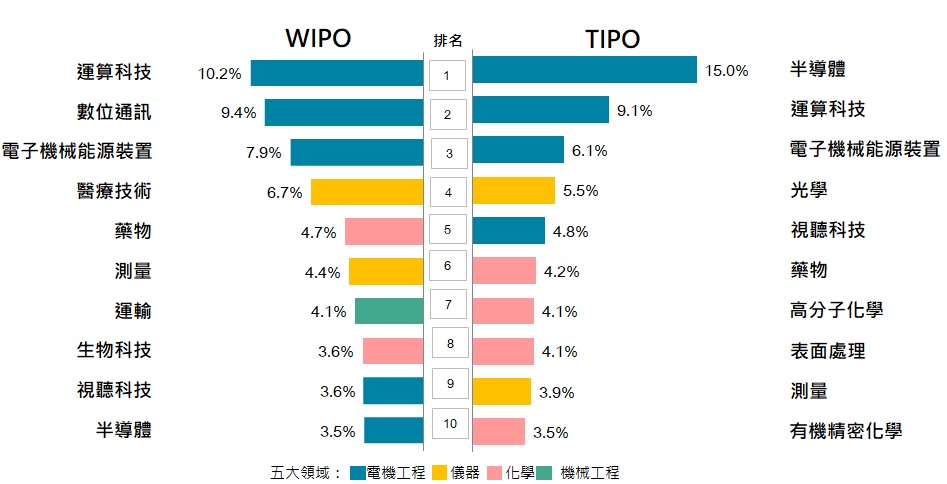 30
30TIPO Releases 2023 Trends & Comparisons: Taiwan Invention Patent Applications and WIPO PCT Applications
The 2023 Trends & Comparisons: Taiwan Invention Patent Applications and WIPO PCT Applications released by TIPO revealed that WIPO received an estimated 272,600 PCT invention patent applications in 2023, a 1.8% year-on-year decrease, ending a 13-year growth streak. In contrast, TIPO received 50,854 applications, marking a 1.2% increase.In 2023, the top three technical fields for WIPO applications were Computer Technology (10.2%), followed by Digital Communication (9.4%) and Electrical Machinery, Apparatus, and Energy (7.9%). For TIPO, the top field was Semiconductors (15.0%), followed by Computer Technology (9.1%) and Electrical Machinery, Apparatus, and Energy (6.1%).Regarding the primary countries/regions and their focus areas under WIPO patent filings, China had the highest share in Digital Communication (15.6%), while the United States focused most heavily on Computer Technology (12.9%). Japan (11.3%) and Germany (11.8%) predominantly filed in the field of Electrical Machinery, Apparatus, and Energy, whereas South Korea showed an equal focus on Electrical Machinery, Apparatus, and Energy and Digital Communication (both at 11.2%). In comparison, Taiwan, China, the United States, Japan, and South Korea all ranked Semiconductors as the top field under TIPO filings, with shares ranging from 12.5% to 25.7%.Under WIPO patent publications, China’s Huawei ranked first for the seventh consecutive year with 6,494 applications, followed by South Korea’s Samsung Electronics (3,924 applications) and the United States’ Qualcomm (3,410 applications). For TIPO patent publications, TSMC (Taiwan Semiconductor Manufacturing Company) took the top spot for the fifth consecutive year with 1,582 applications, followed by Applied Materials (794 applications) from the US, Samsung Electronics (747 applications) from South Korea, and Qualcomm (695 applications) from the US. Notably, both Samsung Electronics and Qualcomm were included among the top 10 applicants in WIPO and TIPO filings.For WIPO, six of the top 10 applicants, including Huawei, focused most heavily on the Digital Communication field. Huawei, in particular, allocated 41.8% of its filings to Digital Communication, followed by Computer Technology (22.7%) and Telecommunications (9.5%), comprising a combined share of 74.0%. Under TIPO, six of the top applicants, including TSMC, concentrated on Semiconductors, with TSMC allocating the largest proportion at 78.1%.Samsung Electronics displayed contrasting filing priorities between WIPO and TIPO, with Digital Communication as the top field for WIPO and leading with Semiconductors for TIPO. Qualcomm, however, maintained Digital Communication as its highest-priority field across both WIPO and TIPO, demonstrating minimal variation in its filing strategy.In Taiwan, Hsinchu City recorded the highest number of invention patent applications with 4,842 filings, setting a new all-time high. It was followed by Taipei City (3,058 filings) and New Taipei City (2,989 filings). The combined filings from the Taipei-Hsinchu region accounted for 72.4% of all domestic invention patent applications.The 2023 Trends & Comparisons: Taiwan Invention Patent Applications and WIPO PCT Applications is now available on TIPO’s official website for public reference.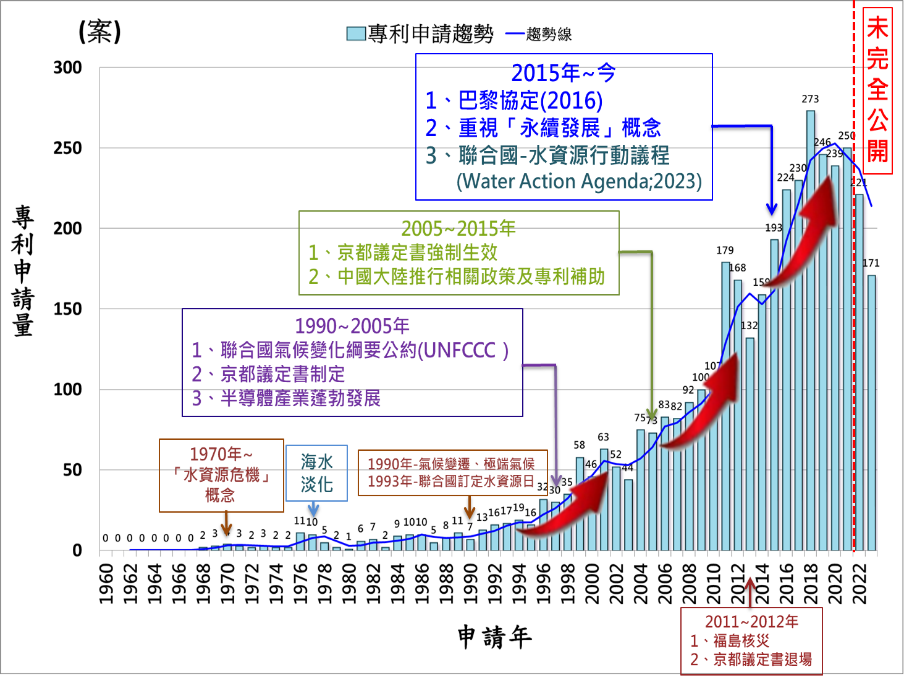 31
31TIPO Releases the Patent Trends on Wastewater Treatment and Recycling Technologies in Semiconductor Industry Report
In line with Taiwan's vision for the sustainable development of the semiconductor industry, TIPO has released the Patent Trends on Wastewater Treatment and Recycling Technologies in Semiconductor Industry Report. The report shares concrete case studies and offers an in-depth analysis of patent development and technology trends in this field, serving as a key reference for industry efforts in promoting green transformation.The report highlights that over the past 20 years, there has been a significant increase in global patent applications related to wastewater treatment and water recycling technologies, reflecting the strong focus of businesses on sustainability and ESG (Environmental, Social, and Governance) issues. Through advancements in wastewater recovery and water recycling technologies, the global semiconductor industry has made notable progress toward sustainable water resource management. As one of the world’s major producers of semiconductor components, Taiwan has a well-established industry chain and technological foundation, with R&D achievements comparable to those of the US, Japan, and Europe. This contributes significantly to Taiwan's goal of achieving net-zero transformation by 2050.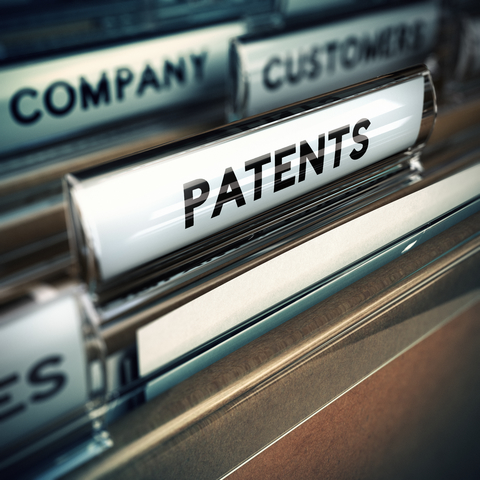 32
32TIPO Publishes English Version of Patent Examination Guidelines, Part II: Substantive Examination for Invention Patents, Chapter 6 “Amendments”
TIPO has released the English version of the Patent Examination Guidelines, Part II: Substantive Examination for Invention Patents, Chapter 6 “Amendments” to enhance the international IP community’s understanding of Taiwan’s patent examination process.This chapter outlines the appropriate timing for proposing amendments and explains how admissibility is evaluated during the examination process. Moreover, it functions as a helpful tool for foreign applicants, enabling them to assess whether their patent applications meet specified Guideline requirements. 33
33New System for Telephone Communication with External Examiners and Remote Video Interview Launched Officially on September 1
Starting September 1, 2024, TIPO has introduced the Optimization Program for Telephone Communication and Remote Video Interviews with External Examiners on a pilot basis. Invention patent applicants can now use TIPO's three-way conference call system to facilitate real-time communication and exchange of opinions between the applicant or their representative, the external examiner, and TIPO examiners. For more complex cases or those requiring demonstrations, a remote video interview can also be arranged, allowing direct interaction with the external examiner and TIPO examiners. This initiative is designed to enhance the quality of patent applications and improve the efficiency of the examination process. 34
34TIPO Invites German IP Experts to Speak in Taiwan
On September 5, 2024, TIPO invited Klaus Bacher, Presiding Judge of the Federal Court of Justice of Germany, along with patent attorneys and partners Dr. Heinz Goddar and Dr. Ute Kilger at Boehmert & Boehmert, to talk on topics such as the "German Federal Court of Justice Ruling on the DABUS Case," the "EU Supplementary Protection Certificates (SPC) and SPC Manufacturing Waiver," and the "2024 EU Artificial Intelligence (AI) Act."The talks featured lively exchange, contributing to a deeper understanding within TIPO of the differences in inventor determinations between Germany, the EPO, and the US, as well as insight into the EU’s Pharmaceuticals Package amendment proposal and the AI Act, which will take effect on August 1, 2024, in the EU. 35
35TIPO Publishes the 2023 Compilation of Selected Court Decisions on Trade Secret Cases on Official Website for Public Reference
To promote public understanding of the development of trade secret judicial practices in Taiwan, TIPO has published the 2023 Compilation of Selected Court Decisions on Trade Secret Cases.22 cases were selected by sifting through 67 civil and criminal decisions relating to trade secrets in 2023, and then examined and categorized based on key issues: the three elements of trade secrets, trade secrets infringement, and trade secrets related rulings Court decisions were summarized, compiled, and have been published on TIPO's official website as of August 13, 2024 in the Trade Secrets section for public reference.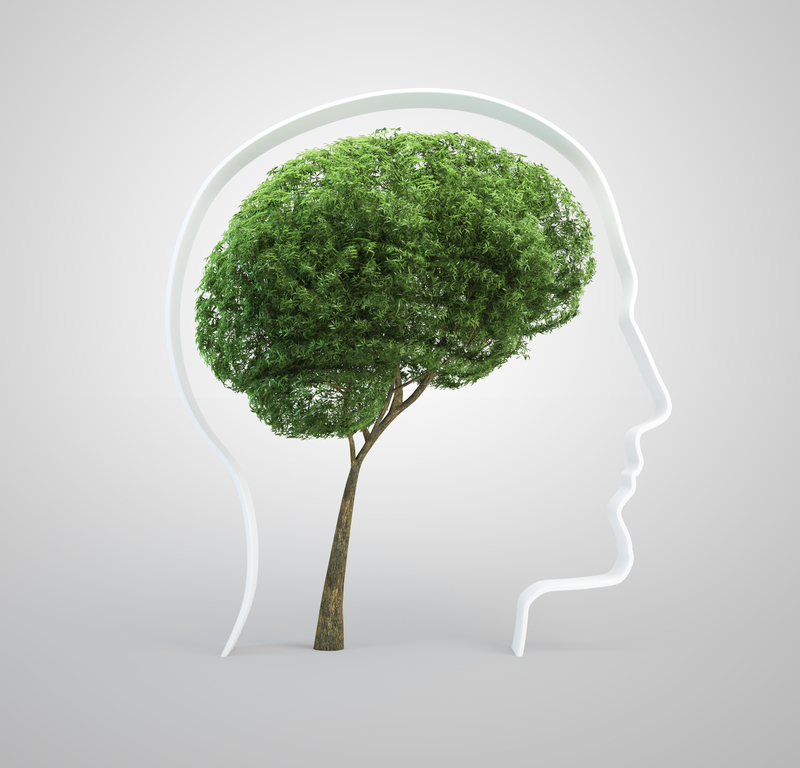 36
36TIPO Releases Analysis of Taiwan's Green Trademark Industry – Now Available for the Public!
Following the 2023 publication of the Comparative Analysis of Taiwan's Green Trademark Industry in the Last Ten Years, TIPO has continued its research by incorporating the latest statistics to analyze the current state of Taiwan's green trademark industry. The newly completed Analysis of Taiwan's Green Trademark Industry offers insights for businesses on how to strategically position their green trademarks to address global climate change and net-zero emission strategies.Referring to the European Union’s definition of green trademarks, TIPO defines "green trademarks" not by the "trademark reproduction" itself but by the designated goods and services contained in the trademark applications and their Nice Classification. The report examines the distribution of applications over the past decade in nine major categories: energy products, transportation, energy conservation, reuse/recycling, pollution control, waste management, agriculture, environmental awareness, and climate change. It also includes data on the number of applications, percentages, and trends in each category.Over the past decade, green trademarks have accounted for approximately 14.49% of all trademark applications in Taiwan, demonstrating an increase from an average of 13.00% in the early period (2014-2016), 15.31% in the mid-term (2017-2020), to 14.64% in the later period (2021-2023). While there was a slight decline in the latter period compared to the mid-term, the long-term trend demonstrates a growing awareness of carbon reduction, low-carbon initiatives, and green energy within trademark applications. The top three categories are energy conservation, pollution control, and energy products, accounting for nearly 80% of all green trademark applications, highlighting the industry's focus in these three key areas.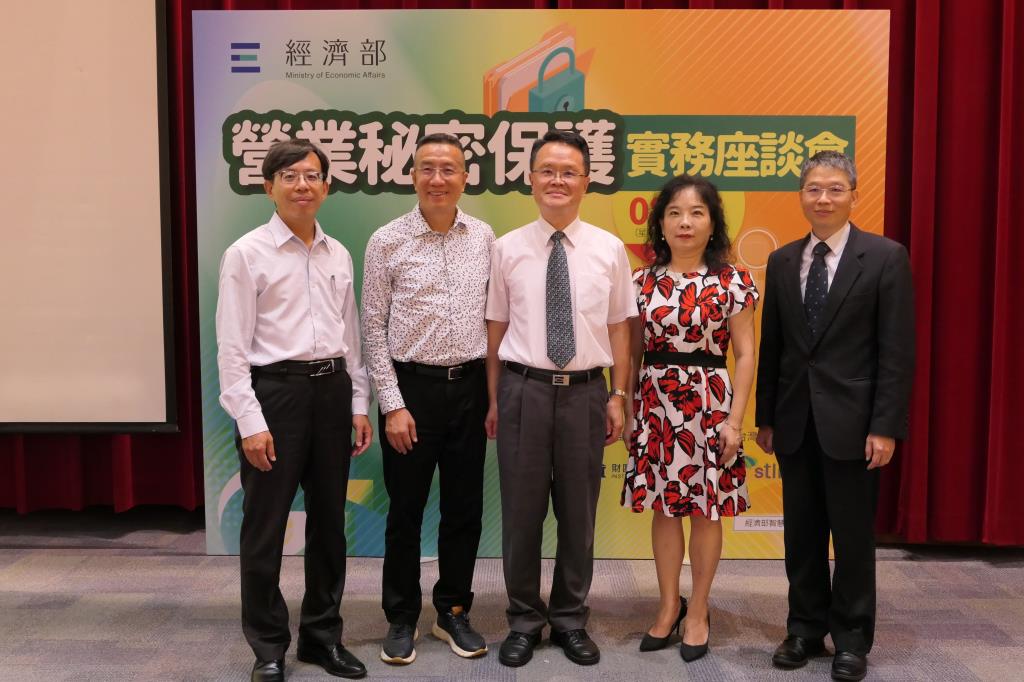 37
37TIPO's Practical Trade Secret Protections in Enterprises Seminar Session for Northern Taiwan Successfully Concludes
To help businesses strengthen their trade secret protection mechanisms, TIPO held the Practical Trade Secret Protections in Enterprises Seminar in Northern Taiwan on August 15, 2024. The Taiwan Association for Trade Secrets Protection was invited to share practices on "How Business Owners Can Protect Trade Secrets."The seminar included a panel on "Trade Secret Protection and Non-Competition Agreements." The panel was moderated by Director-General Cheng Yi-Yi of the Judicial Yuan and included panelists such as Associate Professor Chen Lung-Sheng, Executive Director Su Wen-Tang, Attorney Hsiung Sung-Mei, and Chief Judge Tsai Zse-Hong of the Judicial Yuan shared their insights on non-competition practices in Taiwan, court jurisdiction, and the potential impact of the recent U.S. Federal Trade Commission (FTC) ban on non-compete agreements, as well as strategies for businesses moving forward. The seminar saw lively discussions between experts and participants from the legal, academic, and business sectors, concluding successfully. 38
38Accelerated Examination Program for Reexamination (AEPRe) hits the road on September 1, 2024
1、To improve the efficiency of the re-examination process, TIPO will launch “Accelerated Examination Program for Re-examination (AEPRe)” on September 1, 2024. For cases where the final rejection decision on substantive examination only reject some claims and there is at least one claim that not rejected, the re-examination process of the re-examination invention case can be accelerated through AEPRe. This program aims to improve the efficiency of the re-examination process and encourage applicants to amend their claims based on the “not rejected claim” provided in the final rejection decision on substantive examination.2、Re-examination invention case that meet the following requirements are eligible for AEPRe and the applicants can receive re-examination results within six months after applying AEPRe:(1) Eligible AEPRe Case:re-examination invention cases where the final rejection decision on substantive examination only reject some claims.2. Eligible AEPRe Request Timing:Within the period from “notified by TIPO that the invention application will soon be undergoing Reexamination” to “received first Reexamination OA.”3. Eligible AEPRe Claim Amendments:Applicants should amend the claims according to Article 49 of the Patent Act and the claim amendments narrow the scope of the claims to be no broader than “the not rejected claim” by the following criteria :a. Delete claims that have grounds for rejection in the final rejection decision on Substantive Examination.b. Simply re-write the dependent claims that are not rejected in the final rejection decision on substantive examination to independent claims.Note:The claim Amendments may make adjustments to claim numbers, dependency relationships, and add new dependent claims to the aforementioned criteria a and b independent claims.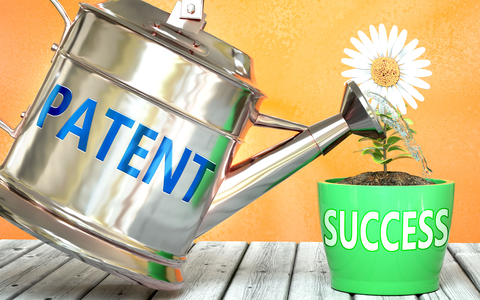 39
39The 2024.01 Edition of the International Patent Classification (IPC) Now Available on TIPO Website
The 2024.01 edition of the International Patent Classification (IPC) has been published on the TIPO website. For new applications filed on or after August 1, 2024 to TIPO, the updated IPC 2024.01 edition shall apply. As a result, the Patent Gazette will be published using the 2024.01 edition starting from August 1, 2024, and the Published Patent Application Gazette will adopt the new classification starting from October 16, 2024.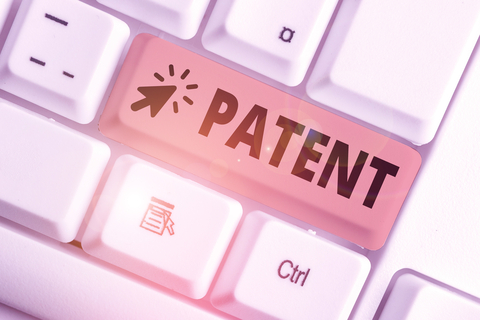 40
40TIPO’s Revisions of the Patent Examination Guidelines Took Effect on July 1, 2024: Part II Chapter 1, 3, 11, 14 and Part V Chapter 1
TIPO has revised its examination guidelines for regulatory alignment, reflect changes in examination practices, unify interpretations, and improve examination quality. Revisions include additional examination principles and case examples, and apply to Part II “Substantive Examination for Invention Patents” (Chapter 1, 3, 11, and 14) and Part V “Examination of Invalidation” (Chapter 1). Revisions have been implemented since July 1, 2024, and key updates include:In alignment with the revisions to Article 17, Paragraph 7 of the Enforcement Rules of the Patent Act regarding sequence listings and TIPO's implementation of the WIPO ST.26 standard, revisions have been made to Chapter 1, Section 1.3.1 of the substantive examination guidelines for invention patents (Enablement Requirement), as well as related content in Chapter 14.Regarding the patentability , Section 2.6.4 on the criteria for determination of lack of novelty based on legal fiction has been updated with a new example (Example 1) that specifically illustrates how to determine the lack of novelty based on legal ficiton.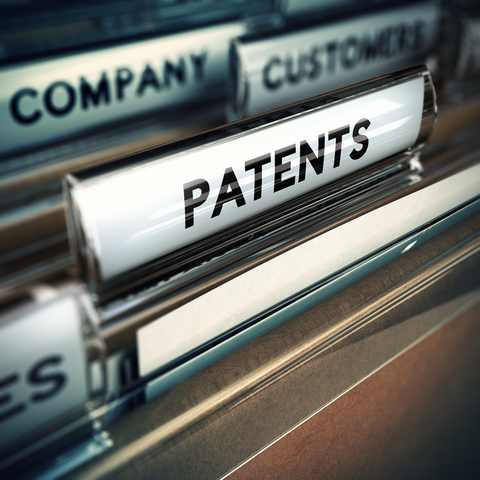 41
41TIPO Publishes English Version of Patent Examination Guidelines, Part II, Chapter 6
TIPO has released the English version of the “Patent Examination Guidelines, Part II: Substantive Examination for Invention Patents, Chapter 6 Amendments” to enhance the international IP community’s understanding of Taiwan’s patent examination process. This chapter outlines the appropriate timing for proposing amendments and explains how their admissibility is evaluated during the examination process. Moreover, it functions as a helpful tool for foreign applicants, enabling them to assess whether their patent applications meet the requirements specified in said Guidelines. To learn more about the “Patent Examination Guidelines, Part II: Substantive Examination for Invention Patents, Chapter 6 Amendments,” please click the link provided below:42
TIPO’s Q2 2024 IPR Statistics Report
Overall Trends in Patent and Trademark ApplicationsIn the second quarter of 2024, TIPO received a total of 17,683 applications for three types of patents, representing a 2% increase compared to the same period last year. This includes 11,988 invention patents, 3,766 utility model patents, and 1,929 design patents (Figure 1). The share of patent applications from resident applicants was 51%, while non-resident applicants accounted for 49%. Compared to the same period in 2023, the number of patents filed by resident applicants decreased by 2%, while the number from non-resident applicants increased by 6%. Overall, there was a 2% increase in the total number of patent applications in this quarter, showing a slight rise in the number of all three types of patents in the second quarter over the past two years.In the second quarter of 2024, a total of 23,885 trademark registration applications were received (covering 29,387 classes), representing a 3% increase compared to the same period last year (Figure 2). Among these applications, 77% were filed by resident applicants and 23% by non-resident applicants. The number of applications has turned to positive growth, compared to the same period over the past year.Overview of Patent Applications Filed by ResidentsTop Ten Invention Patent ApplicantsResidents filed 4,699 invention patents, of which 3,734 were filed by corporations. Among the top ten applicants, TSMC ranked first with 308 applications, followed by Nanya Technology (136), AU Optronics (114), Inventec (90), Innolux (80), Acer (74), Realtek (70), UMC (65), MediaTek (49), and Delta (45)(Figure 4). TSMC has maintained the top position for eight consecutive years since the second quarter of 2017.Top Five Design Patent ApplicantsResidents filed 855 design patent applications. The top five applicants were: Shu-Te University with 22 applications, followed by L&F Plastics (16), Compal (15), Tong Yah (14), and Delta and Vanung University (both 13)(Figure 5).Overview of Patent Applications Filed by Non-ResidentsTop Ten Invention Patent ApplicantsNon-residents filed 7,289 invention patent applications. Among the top ten applicants, Applied Materials from the US ranked first with 208 applications, returning to the top position. The remaining top applicants were: Samsung Electronics (202) from R. Korea, Qualcomm (191) from the US, Tokyo Electron (128) from Japan, Coupang (108) from R. Korea, Screen Holdings and Nitto Denko (both 90) from Japan, Shin-Etsu Chemical (73) from Japan, Lam Research (69) from the US, and ASML (67) from the Netherlands (Figure 4).Filing Countries (Regions) of Invention Patent ApplicantsThe top five countries (regions) for invention patent applications are Japan with 2,726 applications, followed by the US (1,696), mainland China (864), R. Korea (677), and Germany (255)(Figure 3). Of these, applications from mainland China and Germany have grown by over 10%, indicating rapid growth.Top Five Design Patent ApplicantsNon-residents filed 1,074 design patent applications. The top five applicants were led by Zhejiang Smart Intelligence from mainland China with 72 applications, followed by Ford Global Technologies (48) from the US, BMW (34) from Germany, Molex from the US and China Wonderland from mainland China (both 29)(Figure 5). Of these, Zhejiang Smart Intelligence has entered the top five for the first time.Filing Countries (Regions) of Design Patent ApplicantsThe top five countries (regions) for design patent applications are Japan with 248 applications, followed by the US (234), mainland China (223), Switzerland (97), and Germany (75)(Figure 3). Notably, the number of applications from the US has surpassed those from Switzerland and mainland China, moving up to the second position. Overview of Trademark Registration ApplicationsTop Ten Resident Applicants for TrademarksThe top ten applicants for trademark registrations are led by Shen-Bian Matzu Temple with 131 applications, followed by Farglory Dome (100), Goli Power (95), Tsai Ho Want Enterprises and Uni-President (both 78), Kao, Jia-Yu (54), First Commercial Bank and Pou Yuen Ji Global (both 50), Mitac Information (44), and Nan I Book (40)(Table 1).NICE Classification of Resident ApplicationsAmong the top three categories of trademark applications by resident applicants, Class 35 (advertising, business management, retail and wholesale services, etc.) led with 3,518 applications, followed by class 43 (restaurants, lodgings, etc.)(1,779), and class 30 (coffee, tea, pastries, etc.)(1,631)(Figure 6). This indicates that trademark applications filed by resident applicants are predominantly concentrated in business management, as well as in consumer services and goods.Top Ten Non-Resident Applicants for TrademarksThe top ten non-resident applicants for trademark registrations are led by Full Comfort from the British Virgin Islands with 68 applications. They are followed by Huawei (62) from mainland China, Zhejiang Kayou Culture Communication (33) from mainland China, Tencent Holdings (32) from the Cayman Islands, Zhejiang Tucson Custom from mainland China and Abercrombie & Fitch from Switzerland (both 30), Nanyang Hongfeng Electrical (28) from mainland China, Blue Origin (26) from Singapore, Onefifteen (22) from Hong Kong, and Shiseido (21) from Japan (Table 2).Filing Countries (Regions) of Non-Resident ApplicationsThe top five countries (regions) for trademark applications are led by mainland China with 1,528 applications, followed by Japan (905), the US (726), R. Korea (438), and Hong Kong (344)(Figure 3).NICE Classification of Non-Resident ApplicationsAmong the top three categories of trademark applications by non-resident applicants, Class 9 (computers and technology products, etc.) led with 1,021 applications, followed by Class 3 (cosmetics and detergents, etc.) and Class 35 (advertising, business management, retail and wholesale services, etc.)(both 634), and Class 5 (pharmaceuticals, etc.)(507)(Figure 7). Notably, Class 9 is the major category for trademark applications for protection by non-resident applicants in Taiwan.Analysis of Applications by IndustryMost trademark applications were classified under “Agriculture” with 6,172 applications, followed by "Health" (4,728), and "Business Services" (4,661)(Figure 8).Among the top three industries for trademark applications, resident applicants are concentrated in "Agriculture" with 5,096 cases, primarily for trademarks related to restaurants and accommodations. Non-resident applicants have the highest number in "Research and Technology" with 1,605 cases. Additionally, both resident and non-resident applicants have seen growth in the number of cases related to "Health," and the number of non-resident applications for "Clothing and Accessories" has increased by 27%. Note: The above statistical data is based on the “first applicant” of the applications when referencing applicants and nationalities.Reference URL: https://www.tipo.gov.tw/en/lp-302-2.html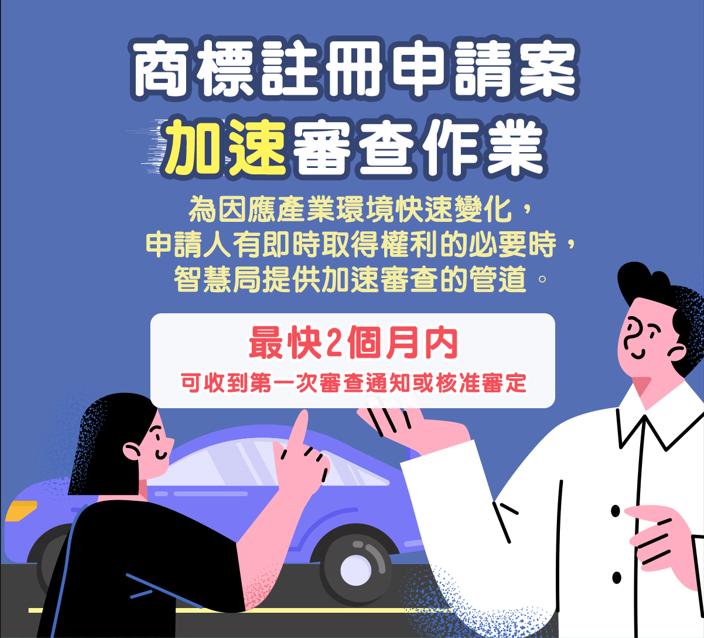 43
43Accelerated Examination for Trademark Registration Applications Takes Effect, Benefitting Applicants in Need of Rapidly Obtaining Trademarks
On May 1, 2024, TIPO launched an accelerated examination for trademark registration applications specifically designed for applicants who urgently need to obtain trademark rights. Applicants must demonstrate the urgency and pay an additional fee for accelerated examination.Generally, the first examination notice will be issued within two months after the application is filed. However, the effectiveness of the accelerated examination may be hampered if notifications for corrections or suspensions are issued during the examination process. The accelerated examination mechanism is introduced in the latest amended Trademark Act, balancing the user-pays principle and avoiding delays in the examination of general applications. This mechanism provides a fast track to obtaining trademark registration, significantly improving the efficiency of trademark registration.TIPO encourages applicants who are in urgent need of obtaining rights to make good use of the accelerated examination mechanism, which will help in trademark rights protection and commercial planning.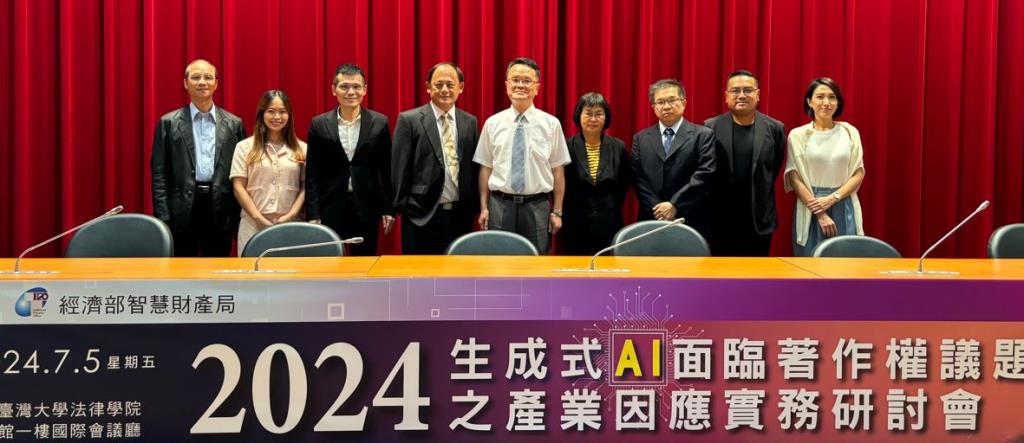 44
44Seminar on Practical Strategies for Addressing Copyright Issues in Generative AI Concludes with Enthusiastic Participation
On July 5, 2024, TIPO hosted the Seminar on Practical Strategies for Addressing Copyright Issues in Generative AI at the International Conference Hall of the NTU College of Law Tsai Lecture Hall. The seminar featured distinguished experts in copyright law and AI industry representatives, including Assistant Professor Chung-Hsin Chang, Copyright academic and expert; Attorney Wenchi Lai; Richard Tzong-Han Tsai, core model training coordinator with RLHF at the TAIDE project, National Science Council; Celeste Yang, Corporate Counsel at Microsoft Taiwan; Claire Lin, Regional Counsel at Google Taiwan; and Ernest Wong, Principal Digital Media Solutions Consultant at Adobe in Hong Kong and Taiwan. These six representatives engaged in in-depth discussions and shared insights on topics such as "Copyright Challenges and Developments in Generative AI" and "Responsible AI Practices and Applications in the Field of Copyright." The seminar attracted over 200 participants from industry, government, and academia, fostering lively interactions and enhancing mutual understanding across different sectors.TIPO Director General Dr. Cheng-Wei Liao emphasized the significance of AI technology and the rapid development of generative AI, which presents new challenges. Balancing the protection of copyright holders' interests with AI industry growth is a matter of careful consideration globally. This seminar provided valuable industry strategies for addressing copyright issues posed by generative AI.TIPO noted that intellectual property (patents, trademarks, and copyrights) is highly harmonized internationally, and the legal framework for AI and copyright involves broad aspects. Understanding the impact of emerging technologies on industry practices is crucial for embracing the opportunities and facing the challenges brought by AI. TIPO will continue to monitor global developments to inform policy-making in Taiwan.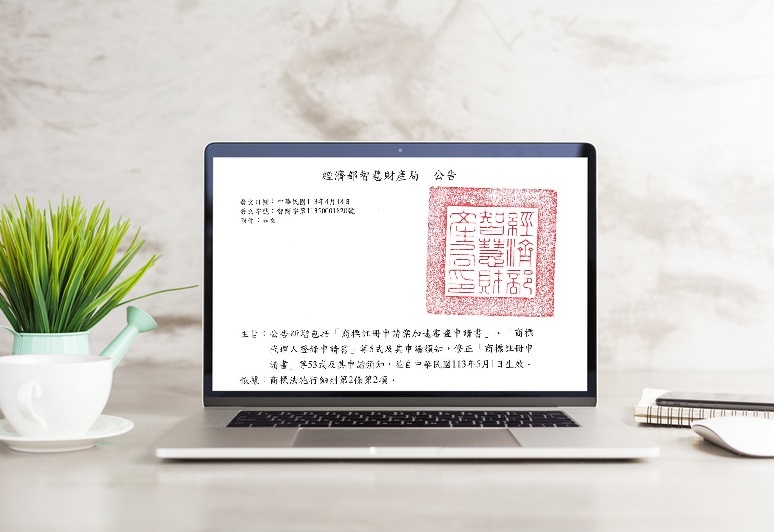 45
45TIPO Revises the Operation Directions on Hearings for Trademark Dispute Cases, Effective June 11, 2024
To provide a more professional and rigorous hearing system while considering the efficiency of relief processes, TIPO has revised the Operation Directions on Hearings for Trademark Dispute Cases based on the Administrative Procedure Act, Regulations Governing Court's Handling of Remote Interrogation in Intellectual Property Case, and other relevant laws. These revisions will serve as the basis for case examination.Key revisions include:I. To strengthen the adjudicative functions of the hearing process, it is stipulated that trademark dispute cases undergoing hearings must be examined by a panel of at least three examiners (Point #3).II. Provisions have been added to allow preparatory hearings based on the complexity of the cases (Point #5).III. Hearings should be conducted orally and publicly; however, if conducted in public would harm the public interest or cause significant damage to the parties, the grounds for requesting a non-public hearing are specified (Point #6).IV. It is specified that if the hearing date or location is changed, the hearing is canceled, or examiners are replaced, the notification and announcement procedures must be reenacted (Point #6).V. The presiding officer may convey his or her legal opinions on factual, legal, and evidentiary issues to an extent appropriate on the case in due course (Point #8).VI. It is stipulated that hearings may be conducted via remote video conferencing, and the methods and legal effects of signing and sealing hearing records are specified (Points #9 and #12). 46
46TIPO Revises the Program for Hearing Patent Invalidation, Effective June 11, 2024
To provide diverse, swift, and professional channels for resolving patent disputes, TIPO has revised the Program for Hearing Patent Invalidation based on previous experiences and industry feedback. Revisions also reference the Administrative Procedure Act, and the revised procedure will serve as the basis for future case examinations.Key revisions include:I. To comply with legal standards, the title has been amended to the “Operation Directions on Hearings for Patent Invalidation Cases.”II. The function of preparatory hearings has been augmented to include formulating and simplifying the issues, clarifying the matters for amendment in the invalidation case, and establishing the key points of attack or defense for the hearing. Both parties are required to adhere to these agreements (Point #5).III. The presiding officer may convey his or her legal opinions on factual, legal, or evidentiary issues to an extent appropriate on the case in due course (Point #8).IV. I. Hearings may now be conducted via remote video conferencing (Point #9).V. I. The effects of absence from the hearing are clearly specified (Points #6 and #9).VI. Hearing records can be summarized with key points and supplemented by audio or video recordings for simplification (Point #12).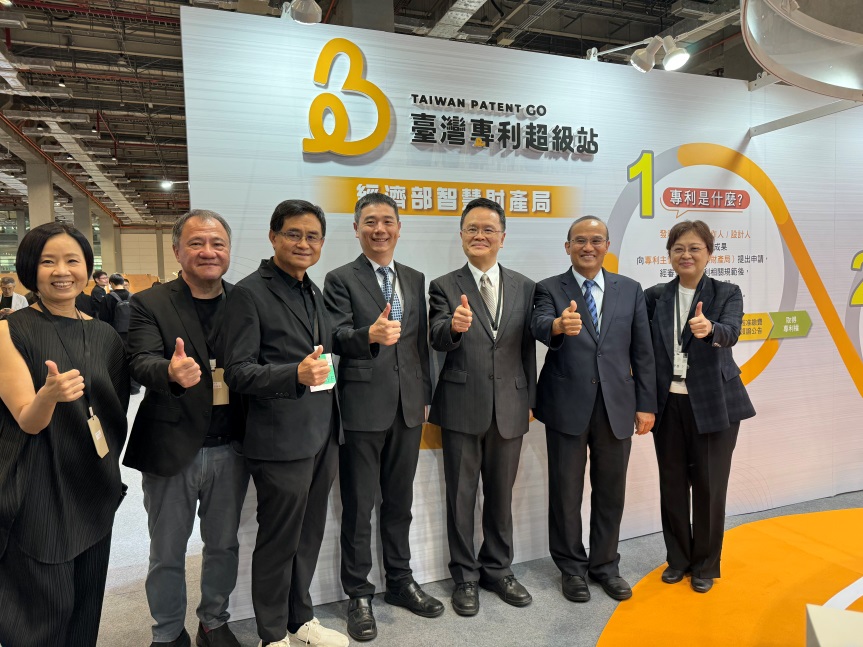 47
47TIPO Lays the Foundation for IP Protection at YODEX
To help participating students and professional designers at YODEX gain a deeper understanding of patents and protect their design works or products through the patent system, TIPO set up the "Taiwan Patent Go" station from May 24 to 27 at the 43rd Young Designers' Exhibition, offering free consultations on design patents.Taiwan Patent Go was one of the focal points for visitors at this exhibition. During the event, Director General Dr. Cheng-Wei Liao of TIPO invited notable guests such as Vice Minister Ching-Chang Lien (former Director General from the Industrial Development Administration), Vice President Oliver Lin, Vice President Nina Ay, and Vice President of Research and Development Shyhnan Liou from the Taiwan Design Research Institute (TDRI). These guests shared their expertise and insights, hoping that the annual setup of Taiwan Patent Go at YODEX would plant the seeds for IPR protection among the new generation of designers.48
TIPO Annual Report 2023 Released
TIPO is pleased to announce the publication of its 2023 Annual Report, highlighting significant developments and achievements in intellectual property rights over the past year. Annual Report 2023 (the whole version) Optimizing Patent and Trademark Examinations●The average first office action pendency and the average disposal pendency for invention patents were 8.9 and 14.4 months, respectively.●The average first office action pendency and the average disposal pendency for trademarks were 6.2 and 7.5 months, respectively.●AI assisted review, speeding up review efficiency: the Patent Specification Error Detection System was launched online in September, and the trademark image search function was completed in November.Bolstering the IPR Regime●Amendments to the Standards for Compensation for Fair Use of Works in Paragraph 3 of Article 47 of Copyright Act were promulgated in April.●Amendments to the Trademark Act passed: accelerated examination program for trademark applications introduced in May.●Revising the Regulations Governing the Determination of Patent Term Extension in JulyInnovative Development of Industry IP●IP Consultations for Core Industries in April : Building Patent Portfolios in Precision Health, Offshore Wind●Patent Analysis for Key Industries in November, i.e. semiconductor industry waste treatment, AI chatbots, etc.Digital Services and Patent/Trademark Searches●The percentages of online patent and trademark applications were 90.3% and 90.6% months, respectively.Expanding International IPR Collaborations●Electronic Exchange of Priority Documents (PDX) for Design Patents between Taiwan and South Korea in July.●Taiwan-US MOU on the Secure Exchange of Patent Data in November.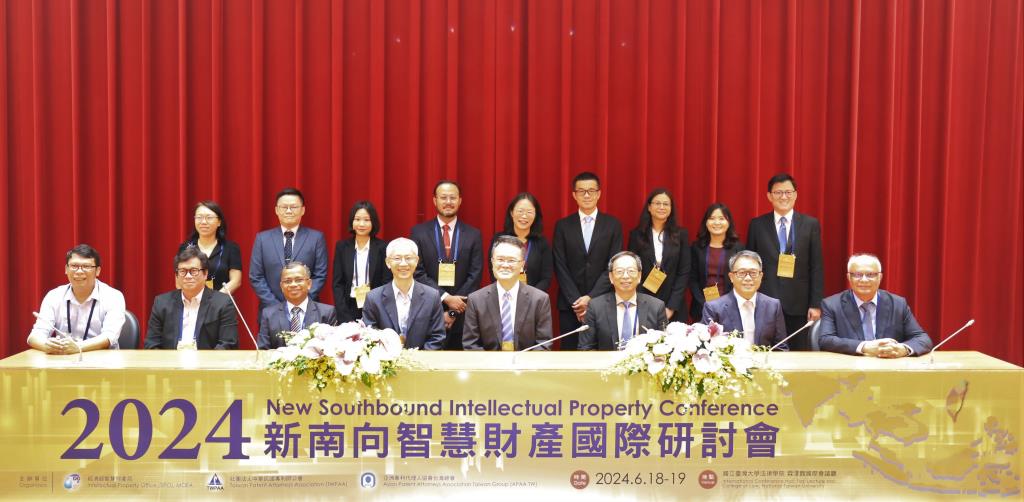 49
492024 New Southbound Intellectual Property Conference Gathers Experts from Seven Countries to Aid Industry in Market Expansion
TIPO, in collaboration with the Taiwan Patent Attorneys Association (TWPAA) and the Asian Patent Attorneys Association (APAA) Taiwan Group, co-organized the 2024 New Southbound Intellectual Property Conference from June 18 to 19, 2024, at the Tsai Lecture Hall, College of Law, National Taiwan University. The event featured representatives from the IP offices and leading patent professionals from seven countries: Malaysia, the Philippines, Singapore, Thailand, Vietnam, Indonesia, and India, who shared the latest developments and practical trends in their respective patent systems. The conference attracted over 210 participants from industry, government, and academia, fostering extensive and lively exchanges of views with experts from Southeast Asia and India.Southeast Asian countries and India commonly contend with issues such as lengthy patent examination times and backlog. Through recent amendments to patent laws, these countries hope to improve the efficiency and quality of patent examination processes. TIPO Director General Dr. Cheng-Wei Liao noted that Taiwan faced similar challenges a decade ago, with examination times reduced from 47 months to the current 14 months. Taiwan is willing to share its experience in clearing patent backlogs and is open to discussing the establishment of Patent Prosecution Highways (PPH) with other countries to alleviate the examination burdens on patent offices.TIPO extends its gratitude to the Taiwan Patent Attorneys Association and the Asian Patent Attorneys Association Taiwan Group for their support and cooperation in successfully organizing this conference, allowing academic and industry experts from various countries to gather and share their experiences. Through introductions to legal systems and practical analyses, the conference provided a comprehensive understanding of the latest developments and trends in patent laws and practices in Southeast Asia and India. This will serve as a valuable reference for Taiwanese enterprises in applying for patents and planning their market strategies, fostering better industrial development.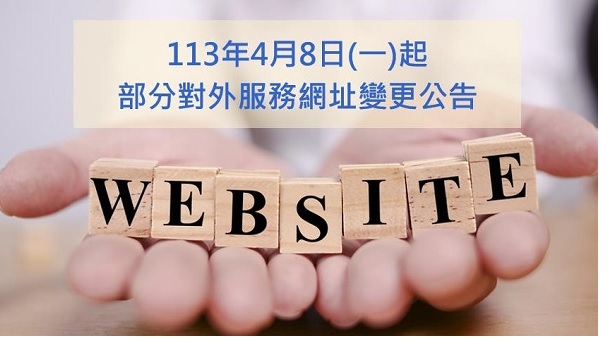 50
50TIPO Updates URLs for Certain Website Services Starting April 8, 2024
To enhance information security and provide more reliable public services, TIPO has updated the links for the following systems as of April 8, 2024. Old links will no longer be available beginning May 1, 2024. For the following services, please access the provided links below:TIPO's Patent Specific Terminology Bilingual Glossary Search: https://tiponet.tipo.gov.tw/IPOTechTerm/login.jspGoods & Services Bilingual Glossary Search: https://tiponet.tipo.gov.tw/IPOTMGoods/login.jspTIPO's Library Search System: https://tiponet.tipo.gov.tw/opac895/login.aspxLink to Download Open Data from DATA.GOV.TW: https://data.gov.tw/datasets/search?p=1&size=10&s=_score_desc&cgl-3=453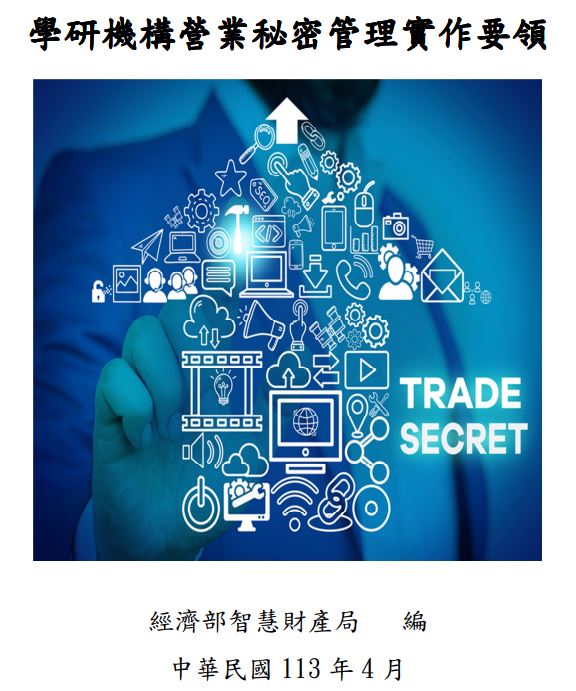 51
51TIPO Shares 13 Strategies for Managing Trade Secrets with Academic and Research Institutions
TIPO helps businesses establish trade secrets protection mechanisms, recognizing that industry innovation relies on robust R&D support. R&D results produced as a result of academic and industry collaboration can also be considered as trade secrets.Given the culture of open sharing among, and the sheer scale of, academic and research institutions, on April 12, TIPO published the Practical Guidelines for Managing Trade Secrets in Academic and Research Institutions. The guidelines are tailored specifically to these institutions and outline 13 practical strategies to gradually establish a management approach suitable for their internal culture. By understanding their internal management systems, personnel, resources, and research areas, these institutions can develop a robust network of trade secret protections that support R&D capabilities and outcomes, bolstering both academic and industry development nationwide.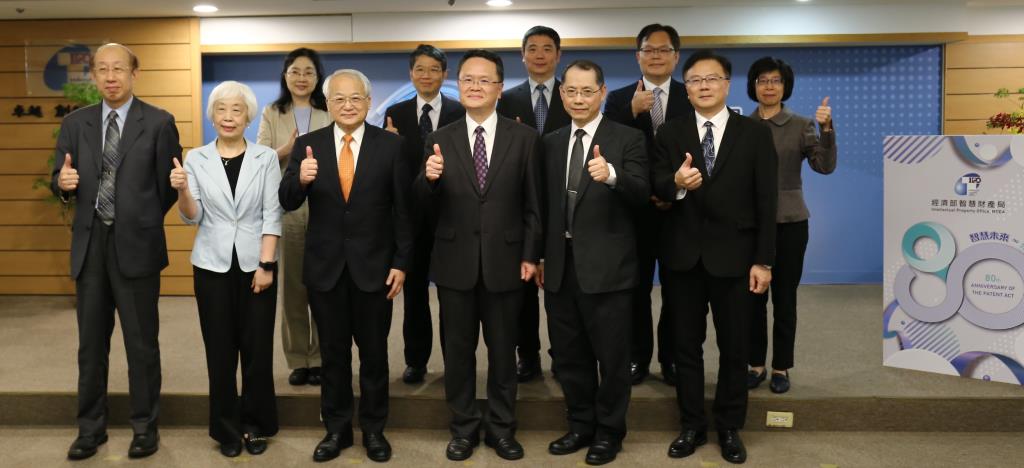 52
5280th Anniversary of the Patent Act – Masters Seminar Series
Taiwan's Patent Act was promulgated on May 29, 1944, and consists of four chapters and 133 articles in its entirety. The act entered into force on January 1, 1949. This year marks the 80th anniversary of the enactment of the Patent Act. In celebration, TIPO held a master seminar series on April 26, coinciding with the celebration of World Intellectual Property Day.This event featured distinguished speakers including former Justice Ming-Cheng Tsai of the Judicial Yuan, Chief Judge Kuo-Cheng Chen of the Supreme Administrative Court, and Vice President & Legal Counsel Peng-Yu Wang from the Industrial Technology Research Institute (ITRI). They delivered lectures on three key topics: "Review and Outlook on the 80th Anniversary of the Enactment of the Patent Act," "The Evolution of Taiwan's Patent Litigation System," and "The Impact of Patent Legislation and Practice on Industry: ITRI's Development Strategies for Intellectual Property." These lectures aimed to deepen public understanding and awareness of our national patent system.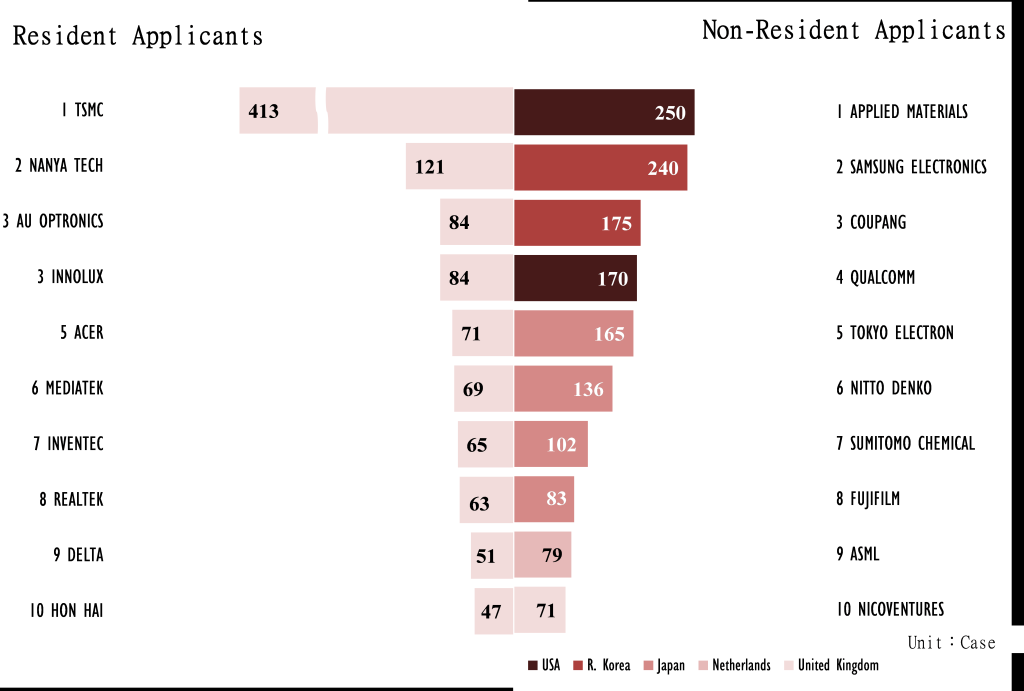 53
53TIPO’s Q1 2024 IPR Statistics Report
Overall Trends in Patent and Trademark ApplicationsIn Q1 2024, TIPO received a total of 16,815 patent applications, comprising 11,989 invention patents, 3,226 utility model patents, and 1,600 design patents (Figure 1). Compared to the same period last year, both invention and design patent applications decreased by 4%, while utility model patent applications increased by 4%. Among these, 49% of the overall patents were filed by resident applicants, and 51% were filed by non-resident applicants. Over the past five years, the first-quarter patent applications have experienced a slight decline for two consecutive years, warranting further attention.TIPO received a total of 21,751 trademark registration applications across 26,928 classes (Figure 2). This represents a slight increase of 1% compared to the same period last year. Among these applications, 78% were filed by resident applicants, while 22% were filed by non-resident applicants. Over the past five years, the first-quarter trademark application trend has shifted from negative to positive, showing a 1% increase.Overview of Patent Applications Filed by ResidentsTop Ten Invention Patent ApplicantsResidents filed a total of 4,492 invention patent applications. Among them, enterprises accounted for 3,655 applications. The top ten applicants for invention patents were as follows: TSMC led with 413 applications, followed by Nanya Tech (121), AU Optronics and Innolux (both 84), Acer (71), MediaTek (69), Inventec (65), Realtek (63), Delta (51), and Hon Hai (47) (Figure 4).TSMC has consistently ranked first for five consecutive quarters since 2023 Q1. Hon Hai, on the other hand, has returned to the top ten applicants since 2022 Q2.Top Five Design Patent ApplicantsResidents filed 753 design patent applications, with the top five applicants being L&F Plastics (21), followed by CGUST and Hi-Joint (both 14), and Gung Chian and Coplus (both 12) (Figure 5).Overview of Patent Applications Filed by Non-ResidentsTop Ten Invention Patent ApplicantsNon-Residents filed a total of 7,497 invention patent applications. The top ten applicants for invention patents were as follows: Applied Materials from US outnumbered all others with 250 applications, Samsung Electronics (240) from R. Korea, Coupang (175) from R. Korea, Qualcomm (170) from the US, Tokyo Electron (165) from Japan, Nitto Denko (136) from Japan, Sumitomo Chemical (102) form Japan, Fujifilm (83) form Japan, ASML (79) from the Netherlands, and Nicoventures (71) from the UK (Figure 4).Filing Countries (Regions) of Invention Patent ApplicantsTop five countries (regions) for invention patent applications: Japan led with 3,325 patent applications, USA (1,526), R. Korea (715), mainland China (698), and Germany (222) (Figure 3). Notably, the number of applications from R. Korea has surpassed that from mainland China in this quarter, moving in rankings from the fourth position to the third position. It is noteworthy that the number of invention patent applications from R. Korea grew by 29% indicating the development of expansion of their patent portfolio in Taiwan.Top Five Design Patent ApplicantsThere were 847 design patent applications filed by non-resident applicants. Among the top five applicants, Volvo from Sweden submitted the highest number of applications (32). The subsequent top applicants were Wonderland (27) from Switzerland, Stellantis (25) from France, and Uni-Charm and Tasaki from Japan (both 19) (Figure 5).Both Volvo and Stellantis have entered the top five for the first time, with Volvo taking the lead.Filing Countries (Regions) of Design Patent ApplicantsTop Five Countries (Regions) for Design Patent Applications: Japan leads with 213 patent applications, USA (138), mainland China (105), Switzerland (91), and France (51) (Figure 3).Overview of Trademark Registration ApplicationsTop Ten Resident Applicants for TrademarksTop ten resident applicants for trademarks: Uni-President led with 311 applications, Momo (72), Wu, Ruo-Mei (48), Thinkpower (47), King Car (39), Kd Flash (36), Chelpis (34), Ever Rich (33), Highwealth (27), and Bionet (26) (Table 1).NICE Classification of Resident ApplicationsTop three classes of resident applications for trademarks: class 35 (advertising, business management, retail and wholesale services, etc.)(3,201), class 43 (restaurants, lodgings, etc.)(1,708), and class 30 (coffee, tea, pastries, etc.)(1,586) (Figure 6). This indicates that resident applications represented a larger share in trademarks related to business management and the catering service industry, and the latter maintained significant market momentum in comparison to the growth rate of trademark applications for goods such as coffee and pastries.Top Ten Non-Resident Applicants for TrademarksTop ten non-resident applicants for trademarks: Quanzhou Baoyu from mainland China led with 56 applications, Tencent (42) from Cayman Islands, Honor Device (39) from mainland China, Pledis (31) from R. Korea, Misto Brand and Chow Sang Sang from Hong Kong (both 29), L' Oreal (24) from France, Beijing Guangyi (22) from mainland China, and Gilead Sciences from Ireland and Artshare from R. Korea (both 21) (Table 2).Filing Countries (Regions) of Non-Resident ApplicationsTop five countries (regions) for trademark applications: mainland China (1,261), Japan (736), US (674), R. Korea (449), and Hong Kong (299) (Figure 3).NICE Classification of Non-Resident ApplicationsTop three classes of non-resident applications for trademarks: class 9 (computer and technology products, etc.)(884), class 35 (advertising, business management, retail and wholesale services, etc.)(600), and class 3 (cosmetics and detergents, etc.)(515) (Figure 7). Among these, non-residents placed greater emphasis of trademark protection on computers, audio-visual equipment, and information technology products in class 9, and retail and wholesale services and online shopping in class 35.Analysis of Applications by IndustryMost trademark applications were filed under “Agriculture” (5,915), followed by “Health” (4,449), and “Business and services” (4,181) (Figure 8). Notably, the fourth-ranking industry is “Research and technology” (3,598), showing a higher growth rate of 5% in the number of applications than that of the top three industries.Resident applications focused on “Agriculture” industry (4,985) were primarily related to trademarks for restaurants and accommodations. On the other hand, non-resident applicants filed the most under “Research and technology” (1,433) (Figure 8). Additionally, positive growth has been seen in both resident applications in “Agriculture” and “Health”, as well as non-resident applications in “Clothing and accessories.”Note: The above statistical data for applicants and nationalities is based on the ‘first applicant.’Reference URL: https://www.tipo.gov.tw/en/lp-302-2.html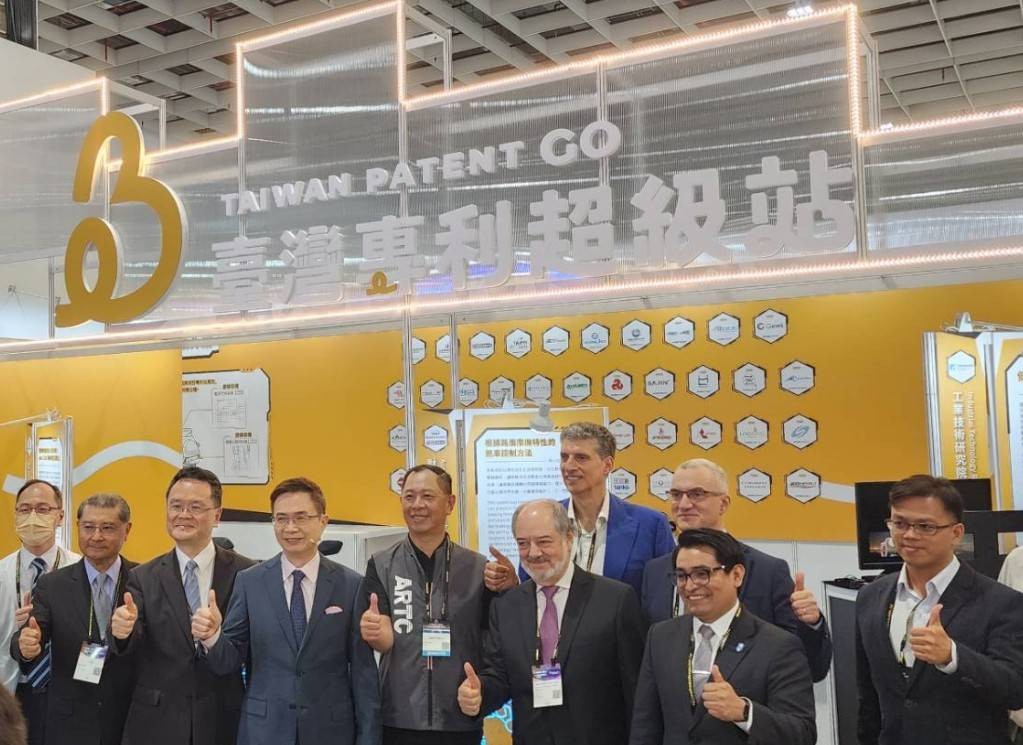 54
54Promoting National Innovation with “Taiwan Patent Go” at Major Expos
In April, TIPO set up the award-winning “Taiwan Patent Go” pavilion at the Taipei International Auto Parts & Accessories Show (TAIPEI AMPA 2024) held at the Taipei Nangang Exhibition Center and the Designed Giftionery Taiwan (DG Taiwan 2024) at the World Trade Center. Taiwan Patent Go showcases promising award-winning patent technologies, offering them exposure through diverse displays and promotions, recommending them to professional buyers, and facilitating matchmaking. These initiatives aim to commercialize these technologies and open new market opportunities, under the banner “Invent in Taiwan. Create for Business.”In celebration of the 80th anniversary of the Patent Act, Taiwan Patent Go also featured special free patent consultation services titled “Coffee Talks on Patents.” Visitors and exhibitors at the pavilion had the opportunity to explore exceptional award-winning patents and receive professional services from patent examiners, patent attorneys, and the staff from the Patent Search Center. Looking forward, Taiwan Patent Go will also be featured at the Young Designer’s Exhibition (YODEX 2024) in May and the Taiwan Innotech Expo (TIE) in October. Visitors from all industries are welcome to visit.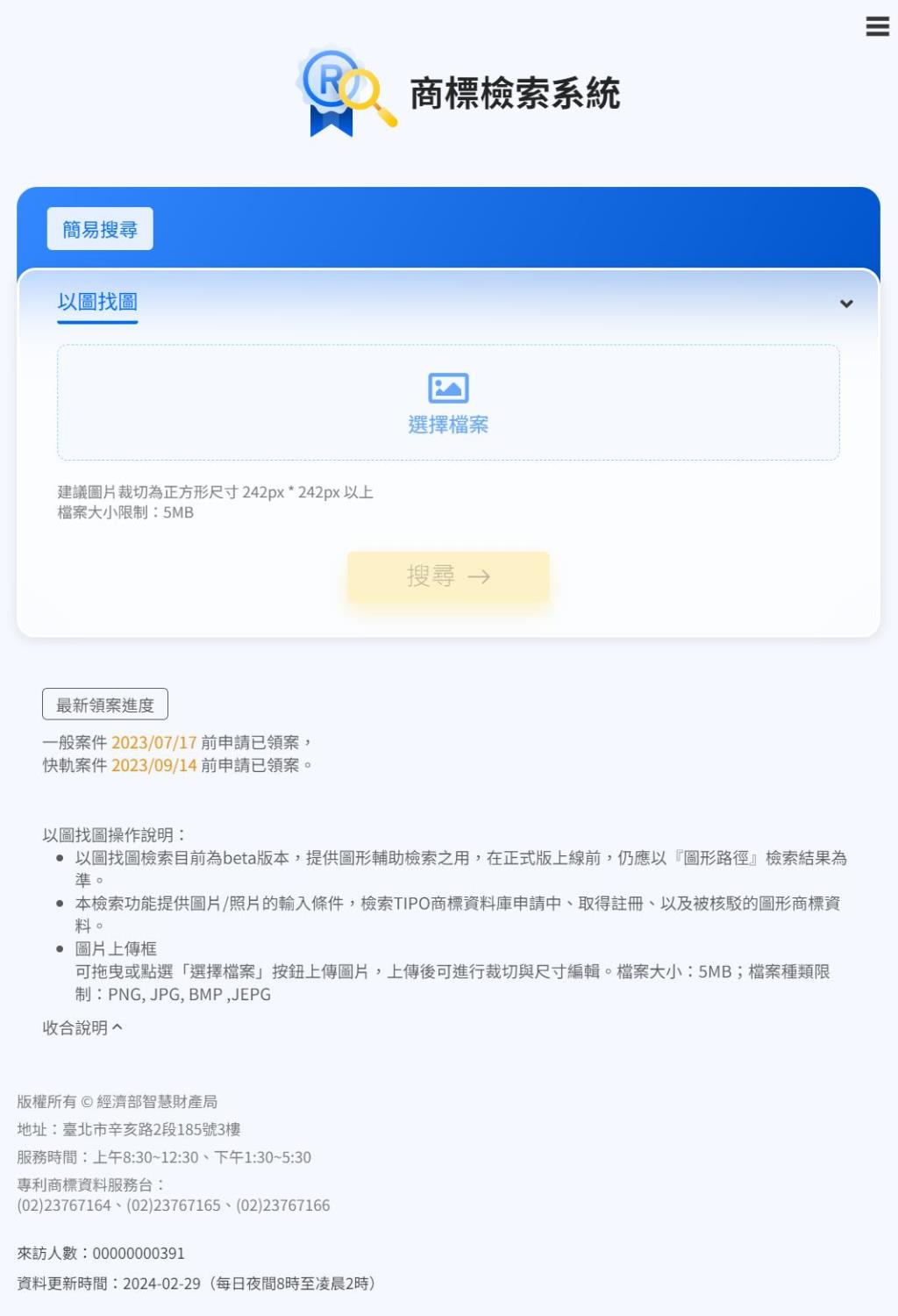 55
55TIPO Introduces New AI “Search by Image” Function
TIPO released a new AI "Search by Image" feature on March 25, which allows the public to upload trademark images and quickly verify whether identical or similar trademarks have already been registered or applied for.The newly launched AI "Search by Image" feature allows users to obtain AI-pre-filtered approximate trademarks without entering any other information. This enables quick comparison with previous cases, reducing the risk of confusingly similar to other trademarks and increasing the chances of successful trademark registration.The feature is still in the beta testing phase, and supplements the current image search system. The public is advised that before the official version is launched, search results should still be based on the current “Graphical Similarity Search” with filters of “Graphic path,” “Goods or Services Name,” or “Group of Similar Goods or Services.”To improve the detection rate of graphical similarities, especially for trademarks combining text and graphics, users are advised to clearly mark the graphical area of the trademark before conducting a search. Additionally, users can combine the current graphical path search method to ensure the comprehensive retrieval of potential trademarks that may constitute graphical similarities.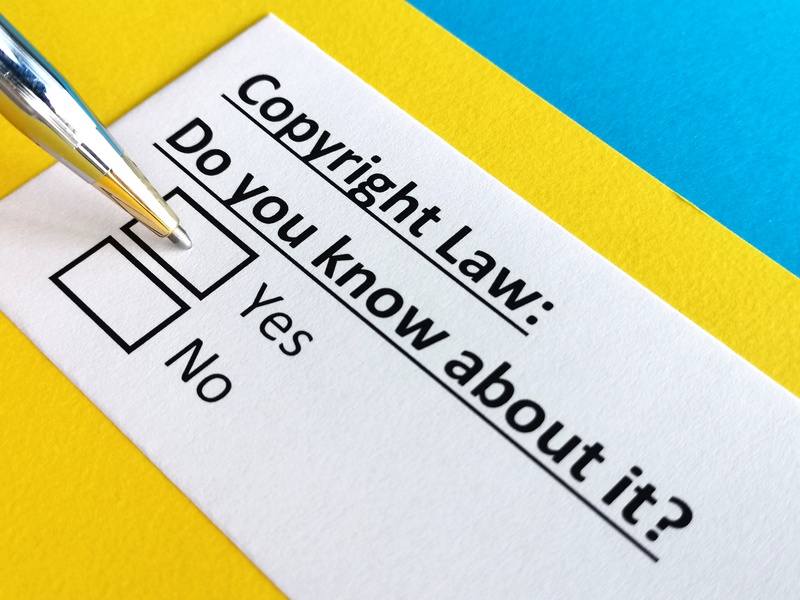 56
56The Latest Version of the Copyrights Inside the Library Has Been Released on TIPO’s Official Website for Public Reference
The Copyrights Inside the Library explains copyright issues related to library operations and usage in a simple and easy-to-understand manner, with Q&A sections addressing common copyright problems encountered in library practices. The publication has become recommended reading for library managers and staff and readers alike.In response to the digitalization needs of libraries, Article 48 of the Copyright Act was amended on June 15, 2022, allowing the National Library to digitize its collection to prevent loss or damage of works, thereby ensuring the complete preservation of contemporary works. The amendment also allows the National Library, as well as general libraries, to provide online reading services to readers within certain restrictions, helping libraries provide digital services.To help the public understand the latest regulations and practical issues related to library copyright, TIPO commissioned the original author Assistant Professor Chung-hsin Chang from Soochow University’s Department of Law to compile an updated version. In addition to retaining the original content, it also addresses the impact of the amendment to Article 48 of the Copyright Law in 2022 on the use and operation of libraries. Copyrights Inside the Library has been published on TIPO’s official website under “Copyright Topics” for public reference.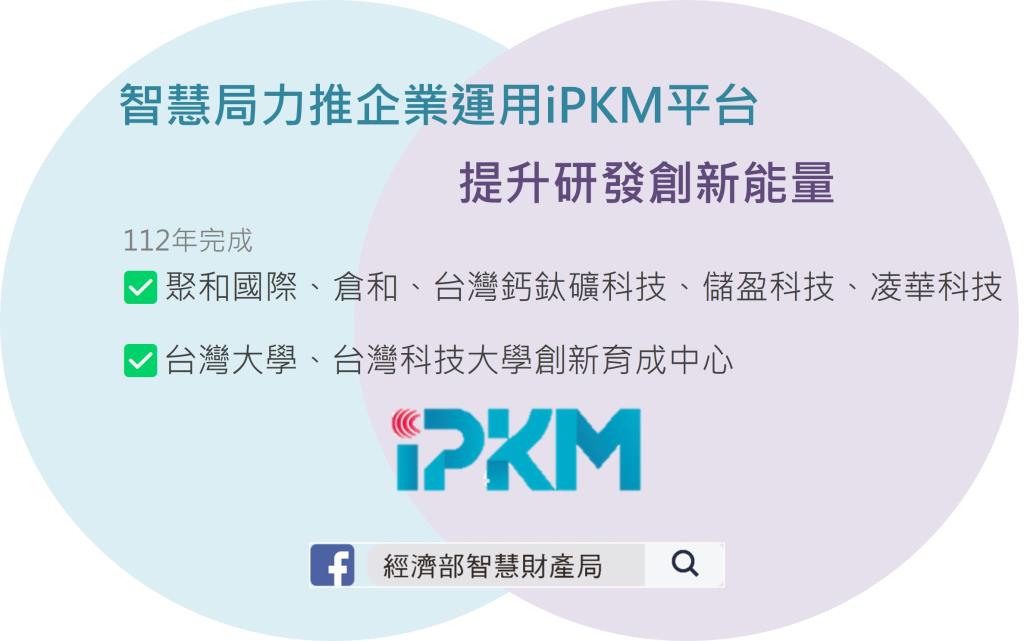 57
57TIPO Encourages Businesses to Utilize iPKM for Greater Innovation & R&D
TIPO released the Industrial Patent Knowledge Platform (“iPKM”) in 2017 to help SMEs in Taiwan develop capacities for R&D and innovation. The site offers a variety of information and smart services, including News, Columns, Patent Trends and Stats, Patent Regimes in Other Countries, Videos, and Recommended Patents, etc.In particular, iPKM News is further categorized into subtopics like Intellectual Property News, Events, and Economic & Trade Info, etc. Users can access the latest government information on intellectual property by browsing, subscribing, and searching through iPKM.iPKM also offers Industry Patent Trends and Recommended Patents, which provides analysis on tech trends and literature on patents to help businesses keep abreast of the latest patent developments across the world.Since 2018, TIPO has also been promoting the iPKM platform and its use to SMEs in select key industries, helping companies develop a basic understanding of intellectual property and become more familiar with operating and using the platform. As of 2023, a total of 162 businesses have benefitted from these services.Additionally, TIPO collaborated with the NTU Innovation and Incubation Center and the NTUST Business Incubation Center in 2023 to provide 221 IP consultations to startups. An overview of the benefits that iPKM has provided to businesses that use the platform has been published on TIPO's official website for public reference.TIPO encourages the public to make use of iPKM and shall continue to provide industry assistance and promote effective use of government platforms and tools. The hope is to bolster patent strategies and technological applications for greater innovation and R&D.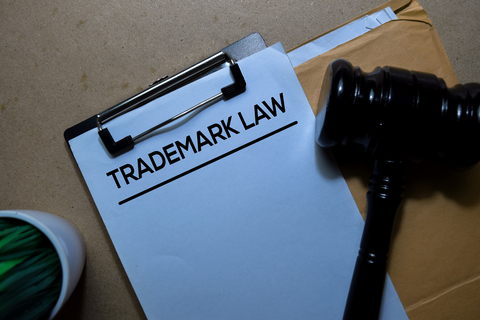 58
58Draft Amendments to the Trademark Act Will Come Into Effect on May 1, 2024
In response to industry and trademark examination practice in Taiwan, as well as to ensure a comprehensive regulatory environment and make relevant adjustments where necessary, draft amendments to the Trademark Act were promulgated in May 24, 2023 and are set to take effect on May 1, 2024. Amendment highlights include:1. Established a mechanism for the registration and management of trademark agents.2. Introduced mechanism for accelerated examination.3. Clearly defines eligibility for trademark applicants.4. Clarify the scope of rights for a trademark while part of its reproduction with functional aspects.5. Clarify nominative fair use, prior good-faith use, and exhaustion of rights that are not bound by trademark rights, in accordance with the application of judicial practices.6. Loosen the requirement for trademark proprietors to identify infringement at Customs.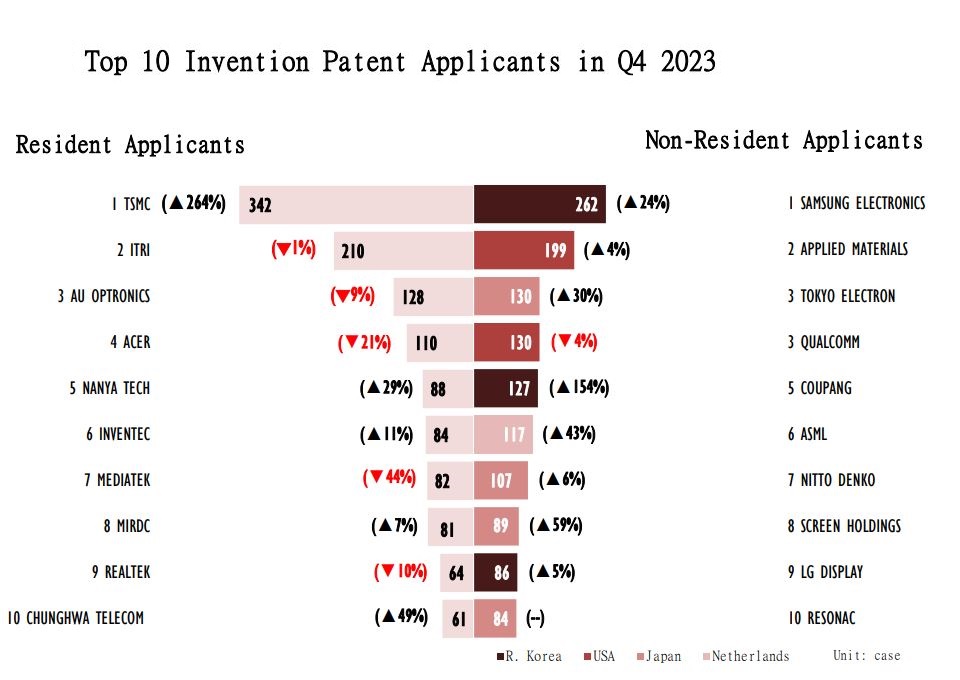 59
59TIPO’s Q4 2023 IPR Statistics Report
In Q4 2023, TIPO received a total of 19,686 patent applications, an increase of 3% compared to the same period last year. Among them, invention patents increased 4% to 13,928. Trademark applications grew 2% to 23,250. As for invention patents, TSMC filed 342 applications, ranking first among residents, while Samsung Electronics (262) led all non-resident applicants for the second year in a row. The top resident and non-resident trademark applicants were Uni-President (235) and International Foodstuffs (81) from the UAE. The number of trademark applications filed by the top 10 resident and non-resident applicants all saw positive growth.Patent ApplicationsIn Q4 2023, TIPO received an overall of 19,686 patent applications. Among them, invention patents (13,928) and design patents (1,921) increased by 4% and 3% respectively, while utility model patents (3,837) decreased by 2%. The number of invention patents filed by residents grew by 3%, and those filed by non-residents across all three patents witnessed growth ranging from 5% to 45% (Table 1).Among the top ten resident applicants of invention patents, TSMC showed significant growth (+264%) by leading with 342 applications, followed by ITRI (210) and AU Optronics (128). However, MediaTek (82) ranked seventh, experiencing a decrease (-44%) due to a higher base period in the same period last year (Figure 2).Among the top five resident applicants for design patents, Acer (22) maintained its top position for the fourth consecutive year, followed by Chang Gung University of Science and Technology (16). Hon Hai (12) entered the top five for the first time since 2020 (Figure 3).Resident applicants filed a total of 5,409 invention patent applications, with enterprises accounting for 4,083 applications (5% increase). However, both colleges and universities (489) and research institutions (384) saw negative growth. Further breakdown by size showed that applications from large enterprises (3,342) and SMEs (741) grew by 6% and 1% respectively.Non-resident applicants filed 8,519 invention patent applications, marking a 5% increase. Among the top five countries (regions), Japan topped with 3,188 applications. Considered alongside Mainland China (1,144) and R. Korea (964), all three showed growth ranging from 8% to 16% (Figure 1).Among the top ten non-resident applicants for invention patents, Samsung Electronics from R. Korea outnumbered all others with 262 applications for the second year in a row. ASML (117) from the Netherlands, Screen Holdings (89) from Japan, LG Display (86) from R. Korea, and Resonac (84) from Japan each set new records for their respective companies. Additionally, Coupang (127) from R. Korea surpassed all others with a remarkable growth of 154% ((Figure 2).Among the top five non-resident applicants for design patents, all exhibited positive growth in the number of applications. Apple from the US not only surpassed other applicants in the number of applications (122) but also achieved a sharp growth rate (+259%). It is particularly noteworthy that Apple’s number of applications has exceeded 100 for the first time since 2013. Moreover, BMW (42) from Germany saw a remarkable increase of 200% as well (Figure 3).Trademark Applications23,250 trademark registrations were filed in 2023 across 29,004 classes, marking a 2% increase. Growth was mainly driven by a 9% growth among non-resident applicants (5,249). On the other hand, those from residents (18,001) saw a slight decrease of 0.5% (Table 1).The number of trademark applications from the top ten residents all showed positive growth, with Uni-President leading with 235 applications. Companies such as CHE TAI (73) and SULINE (55) showed sharp growth due to their lower base periods (Table 2). A breakdown by NICE classification shows that the highest number of residents (3,531) filed under class 35 (advertising, business management, retail and wholesale services, etc.) (Figure 4).Non-resident trademark applications were predominantly from Mainland China (1,185)(Figure 1). The number of applications from the top ten non-residents all showed positive growth as well. Of these, International Foodstuffs from the UAE) topped with 81 applications (Table 3). A breakdown by NICE classsification shows that non-resident applicants filed the most applications (1,025) in Class 9 (Computer and technology products, etc.)(Figure 5).Among industries, most trademark applications were filed under “Agriculture” (6,251), followed by “Business Services” (4,722), and “Health” (4,601) (Figure 6).Resident applicants showed a preference for "Agriculture" (5,218), mainly due to the larger number of trademarks applications in the restaurant and accommodation sectors. On the other hand, non-resident applicants have the most applications in "Research and technology" (1,590). Moreover, trademark applications filed under "Agriculture" by residents, as well as “Health” and “Clothing and accessories” by non-residents, experienced a shift from negative to positive growth.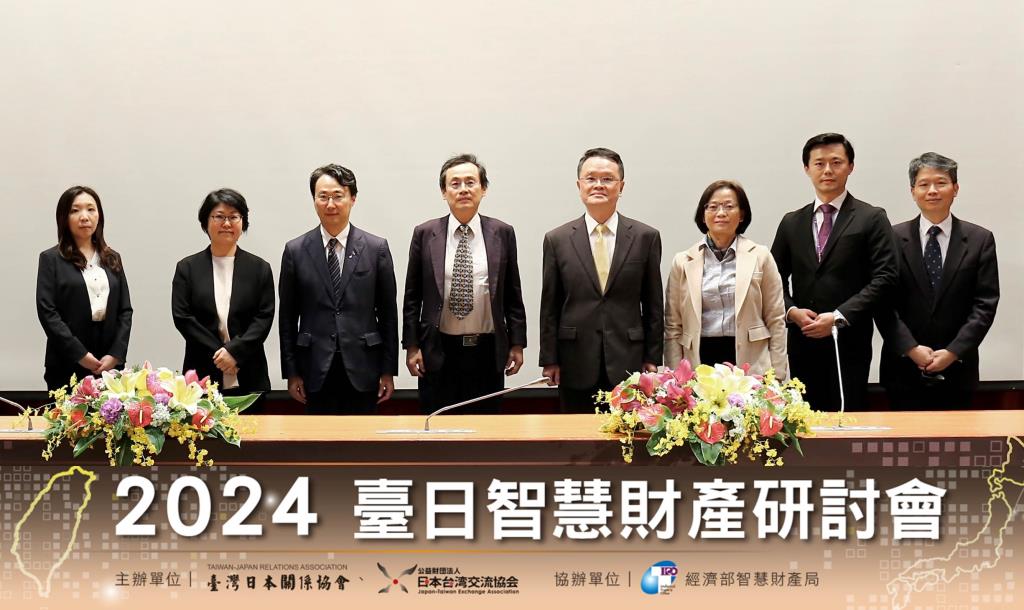 60
602024 Taiwan-Japan Intellectual Property Symposium Concludes to Widespread Participation and Support
The 2024 Taiwan-Japan Intellectual Property Symposium, a collaborative effort of the organizers Taiwan-Japan Relations Association and Japan-Taiwan Exchange Association, in partnership with Taiwan Intellectual Property Office (TIPO), opened on February 2, 2024 (Friday) at the NTU College of Law Tsai Lecture Hall. Remarks were delivered by distinguished guests including Taiwan-Japan Relations Association Deputy Secretary-General Ching-Hung Lin, Japan-Taiwan Exchange Association Deputy Representative Dr. Takashi Hattori, Taiwan Intellectual Property Office (TIPO) Director-General Dr. Cheng-Wei Liao. And also, Japan Patent Office (JPO) Director-General of Policy Planning and Coordination Department, Mr. Mikiharu Shimizu made some closing remarks which summarized the main points of the symposium.Speakers invited to the symposium included Director Masashi Omine from JPO Design Registration System Planning Office, Chief Judge Huei-Ju Tsai from the IP and Commercial Court, Senior Patent Examiner Ming-Feng Hsu from TIPO Patent Administration & Planning Division, and IP Lawyer Kaoru Kuroda from Abe, Ikubo & Katayama. Topics covered the protection of digital designs under the Japanese Design Act, the relationship between the metaverse and design patents, case studies of the utilization of design patent rights in Japan, and judicial practices of design patents in Taiwan.First, Director Masashi Omine gave an introduction to Japan’s Design Act, recent trends in design applications related to images, buildings, and interior decorations, as well as key revisions in the practical application and Examination Guidelines for Designs Including a Graphic Image. Senior Patent Examiner Ming-Feng Hsu then discussed international case studies related to the metaverse and practical protection of cross-disciplinary design applications, i.e. design patent infringement case against the Detroit Red Wings, and the invalidation of Candy Crush virtual candies in the EU.In addition, IP Lawyer Kaoru Kuroda from Japan shared examples of the utilization of design patent rights in Japan, highlighting the criteria for determining design patent infringement. Finally, Chief Judge Huei-Ju Tsai from the IP and Commercial Court used specific judicial cases in Taiwan to explain the process of design evaluation in the courts, including the overall observation, comparison of "common features" and "differential features," methods for ordinary consumers to determine whether they are similar, and key points to consider in visual effect judgments.The 2024 symposium garnered over 140 participants from the industry, government, and academia, who engaged in extensive exchange with experts from both Taiwan and Japan. By providing detailed information on regulations and relevant practices, TIPO hopes to facilitate better public understanding for the design patent regime and judicial practices of Taiwan and Japan. TIPO also hopes that it will serve as a reference for Taiwanese companies when applying for design patents and setting up patent portfolios in Japan.

 Sitemap
Sitemap FAQs
FAQs Feedback
Feedback Bilingual Glossary
Bilingual Glossary